Welcome to our guide on the many varieties of Monstera plants! Often referred to as the “Swiss Cheese Plant” due to its unique leaf structure, the Monstera is a tropical beauty known for its large, perforated leaves. With many different types of Monstera to choose from, it can be overwhelming to decide which one is the best fit for your home or garden.
In this blog post, we’ll take a closer look at some of the most popular and interesting varieties, complete with pictures to help you identify them. Whether you’re a seasoned plant enthusiast or just getting started with indoor gardening, we hope this guide will help you make an informed decision on the perfect Monstera for your space.
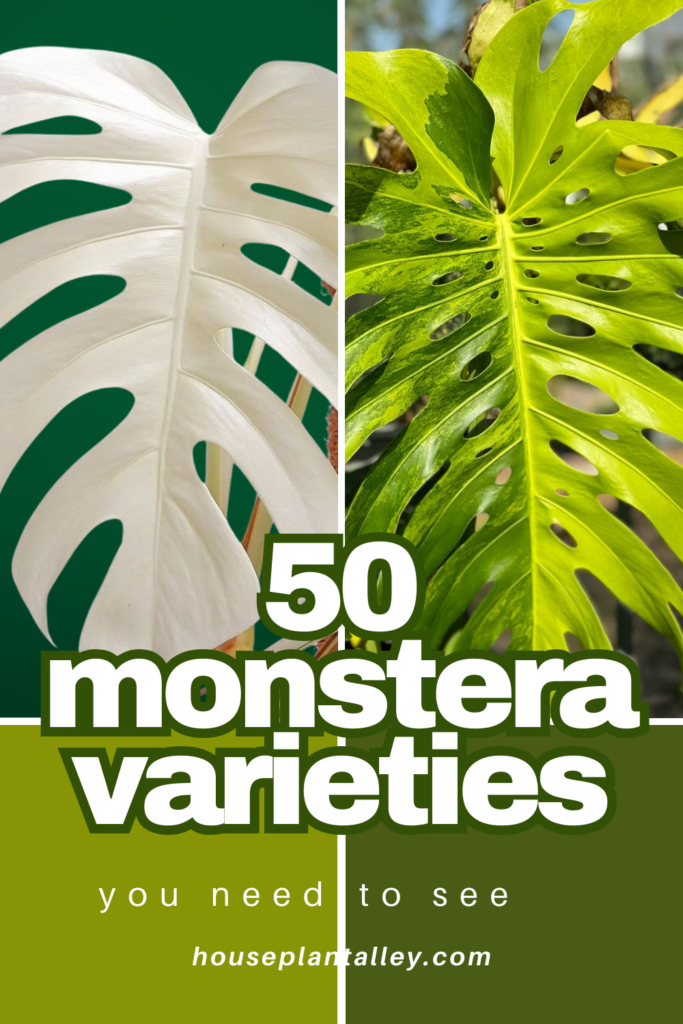
Contents
- 1 Types Of Monstera
- 1.1 Monstera acacoyaguensis
- 1.2 Monstera acuminata
- 1.3 Monstera adansonii
- 1.4 Monstera alcirana
- 1.5 Monstera anomala
- 1.6 Monstera aureopinnata
- 1.7 Monstera barrieri
- 1.8 Monstera borsigiana
- 1.9 Monstera ‘Burle Marx Flame’
- 1.10 Monstera buseyi
- 1.11 Monstera costaricensis
- 1.12 Monstera croatii
- 1.13 Monstera deliciosa
- 1.14 Monstera deliciosa Form 6
- 1.15 Monstera deliciosa Form 7
- 1.16 Monstera deliciosa ‘Thai Constellation’
- 1.17 Monstera deliciosa ‘Yellow Marilyn’
- 1.18 Monstera dissecta
- 1.19 Monstera dubia
- 1.20 Monstera egregia
- 1.21 Monstera epipremnoides
- 1.22 Monstera filamentosa
- 1.23 Monstera Ginny
- 1.24 Monstera glaucescens
- 1.25 Monstera gracilis
- 1.26 Monstera guzmanjacobiae
- 1.27 Monstera integrifolia
- 1.28 Monstera juliusii
- 1.29 Monstera karstenianum
- 1.30 Monstera lechleriana
- 1.31 Monstera lentii
- 1.32 Monstera limitaris
- 1.33 Monstera membranacea
- 1.34 Monstera minima
- 1.35 Monstera molinae
- 1.36 Monstera monteverdensis
- 1.37 Monstera obliqua
- 1.38 Monstera oreophila
- 1.39 Monstera pinnatipartita
- 1.40 Monstera pittieri
- 1.41 Monstera planadensis
- 1.42 Monstera praetermissa
- 1.43 Monstera punctulata
- 1.44 Monstera siltepecana
- 1.45 Monstera spruceana
- 1.46 Monstera standleyana
- 1.47 Monstera subpinnata
- 1.48 Monstera tacanaensis
- 1.49 Monstera tenuis
- 1.50 Monstera tuberculata
- 1.51 Monstera xanthospatha
Types Of Monstera
Monstera acacoyaguensis

The Monstera acacoyaguensis is a tropical plant that is native to Mexico, Guatemala, and Belize. When grown indoors, it typically reaches a height of 4 to 6 feet, but in its natural habitat, it can grow up to 20 feet tall.
The leaves of the Monstera acacoyaguensis are oval-shaped and glossy green in color, with a leathery texture. As the plant matures, the leaves become larger and develop perforations along the edges, giving them a unique appearance similar to that of Swiss cheese. The stems of the plant are green and vine-like, rather than the traditional appearance of plant stems.
The flowers of the Monstera acacoyaguensis are small and yellow in color, arranged on a spadix that is surrounded by a leathery spathe with a yellowish-green appearance.
It is important to note that the Monstera acacoyaguensis is toxic to humans and pets, so it should be kept out of reach of children and pets to avoid any accidental ingestion.
Monstera acuminata
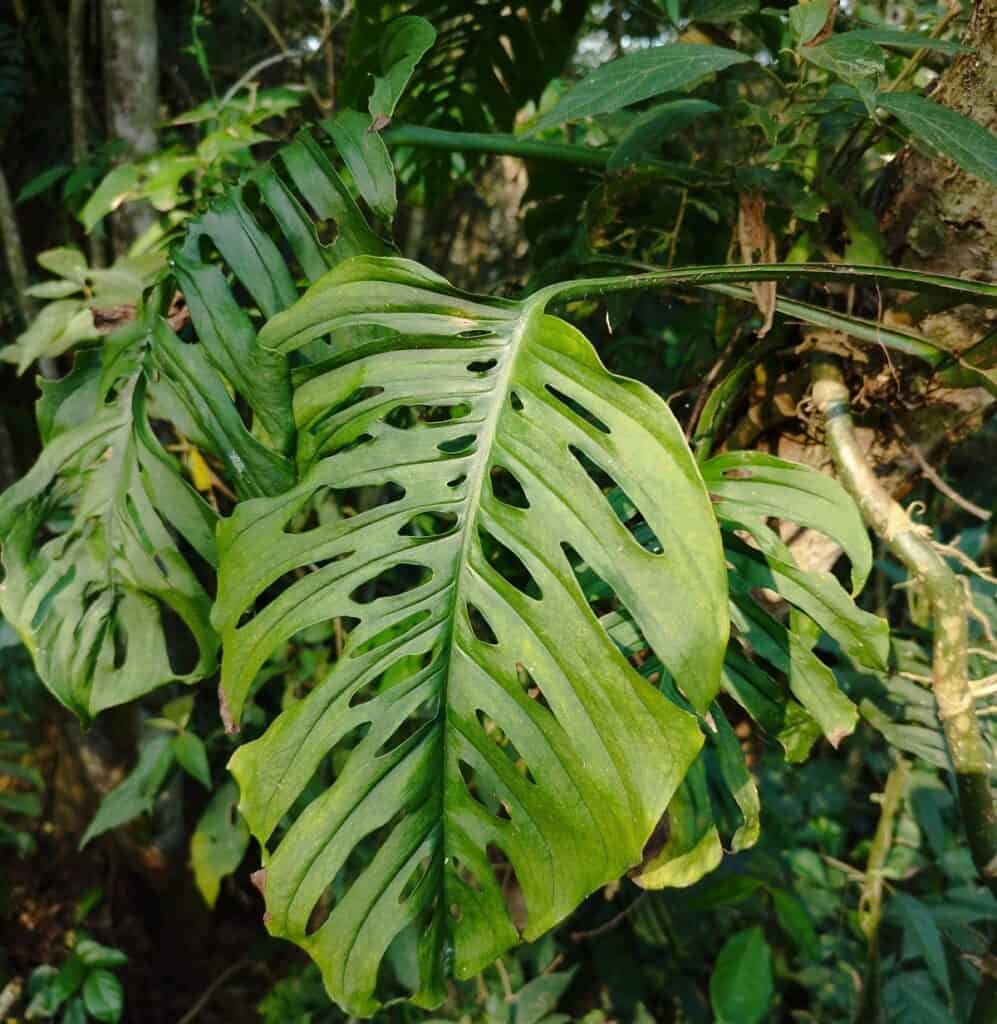
Monstera acuminata is a climbing, tropical plant that is known for its characteristic fenestrated leaves. It grows more slowly when it’s young and ramps up its growth rate as it matures. In the wild, the young plant will creep along the ground until it finds a tree or other surface to climb. As the plant matures and climbs higher toward the rainforest canopy, it will start to develop those characteristic fenestrations.
The Monstera acuminata also reproduces by putting out runners (long, leafless stems) that can sometimes reach up to 65 feet long. In the wild, it can grow up to 65 feet in length, but usually won’t exceed 7 or 8 feet long indoors. It can take several years of the right growing conditions to reach its maximum indoor length.
In its juvenile form, the leaves of Monstera acuminata are very heart-shaped, thick, waxy and around 4 inches long, but leaves on a mature plant can reach up to 10 inches long. When the plant is young, its leaves grow in a shingle pattern, sometimes overlapping each other and lying close to the surface it’s growing on, much like Monstera dubia, another popular, smaller monstera variety. Fenestrations may not show up on smaller plants for several years. This makes it easy to tell young plants apart from acuminata’s similar cousin, the adansonii, which produces fenestrated leaves from the get-go.
Monstera acuminata grows cream-colored incandescences, which are clusters of small flowers. Once the plant has matured, it can bloom year-round, though it rarely blooms indoors. In the proper conditions, this plant also grows small, berry-like fruits.
Monstera adansonii
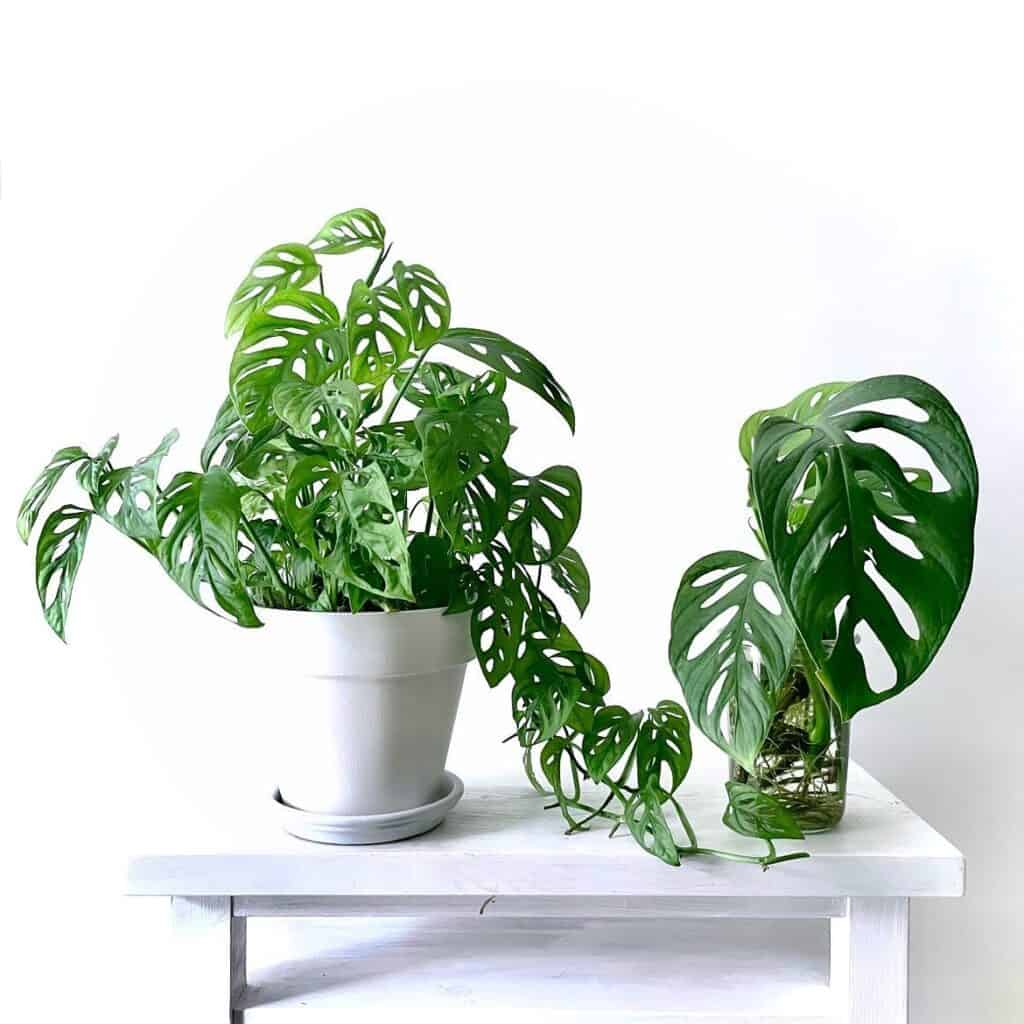
Monstera adansonii is a tropical, jungle plant that is native to Central and South America, parts of southern Mexico, and the West Indies. It is part of the Araceae plant family and looks similar to its cousin, Monstera deliciosa, but does not grow anywhere near as large. Instead of the huge indents in their leaves, they develop large oval holes as they mature, giving them the appearance of swiss cheese.
The leaf of the Monstera adansonii is heart or oval-shaped, designed to capture sunlight efficiently despite all those holes. These plants typically dwell deep in tropical rainforests and need only indirect bright lighting to thrive. As the plant matures, its leaves gradually develop more and more of their distinctive holes. These holes serve another purpose beyond filtering the sunlight down to the plant, by allowing the plant to resist high winds by simply letting the breeze pass on through. And unlike its relative M. deliciosa, M. adansonii always keeps the full edges of its leaf, so the holes remain holes instead of deep indentations.
In the spring months, Monstera adansonii develops a cream-colored flower with hints of purple. It does not always appear for home growers, but in the wild, it’s a common sight. A popular cultivar of this plant is Monstera adansonii ‘Archipelago’, which has variegated leaf coloring, making it even more visually appealing.
The plant’s growth habit is as a climber. It produces aerial roots from the stem which can grasp onto the bark of trees or other foliage. However, it also makes a beautiful cascading plant in a hanging basket. Monstera adansonii is notoriously quick and easy to grow, no matter which way you choose to grow it.
Monstera alcirana
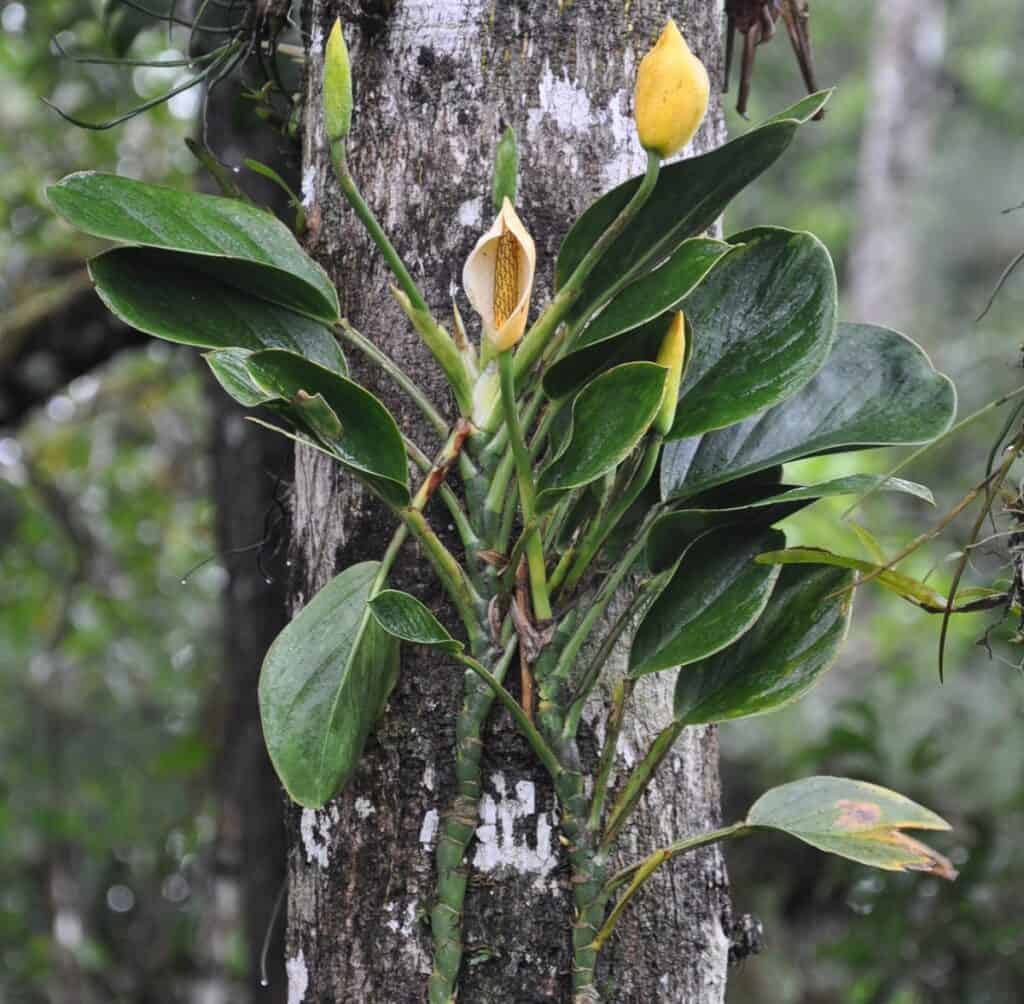
Monstera alcirana is a species of tropical plant that is endemic to Panamá. It is one of the small species of Monstera in Central America and is morphologically similar to other species such as M. obliqua, M. minima, and M. gambensis. However, it can be distinguished by its short internodes, thickly coriaceous (leathery) blade, and peduncle that is longer than the length of the leaf.
The leaves of Monstera alcirana are glossy green in color and have a thick, leathery texture. The leaves are oval-shaped and have smooth edges. The stems of the plant are green and vine-like in appearance.
This species of Monstera is not commonly found in cultivation, and not much is known about its growth habit and requirements. It is important to note that Monstera alcirana is not commonly found for sale and as such, it is considered a rare plant.
Monstera anomala
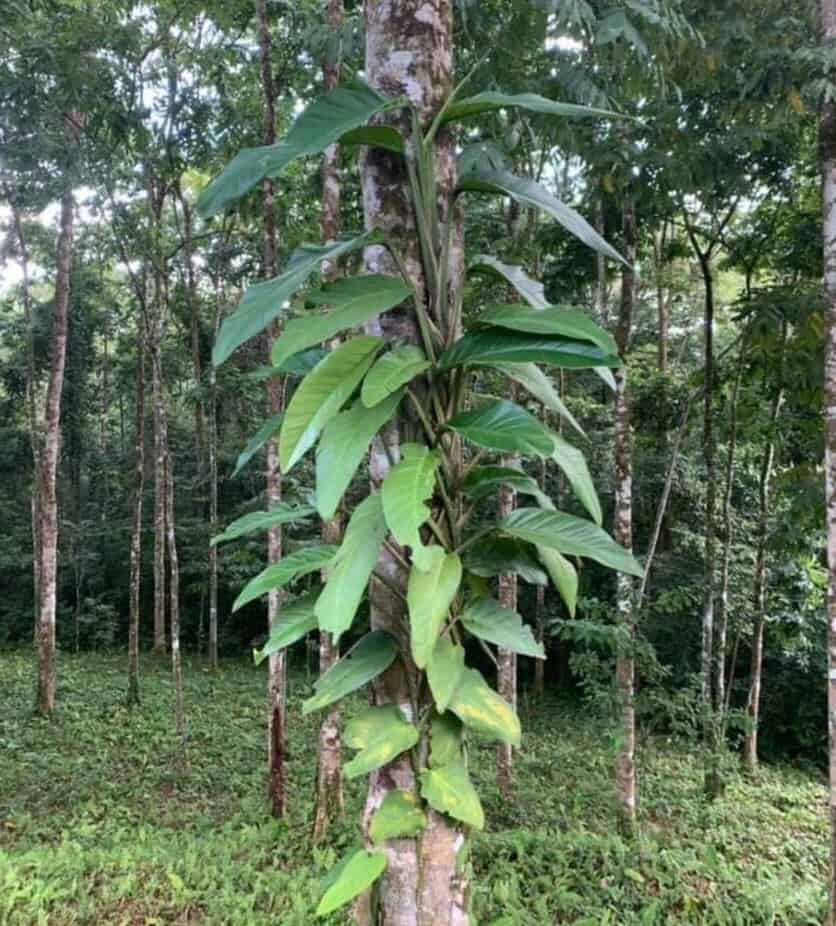
Monstera anomala is a tropical, climbing plant that is native to Costa Rica to Panama. It grows primarily in the wet tropical biome and is known for its glossy green leaves. The leaves are typically oval-shaped, and as the plant matures, the leaves become larger and develop fenestrations along the edges.
The stems of the Monstera anomala are green and are vine-like in appearance. They produce aerial roots from the stem which can grasp onto the bark of trees or other foliage, allowing it to climb and thrive in its natural habitat.
The plant is not commonly found in cultivation, not much is known about its growth habits and requirements. It is considered a rare plant.
Monstera aureopinnata
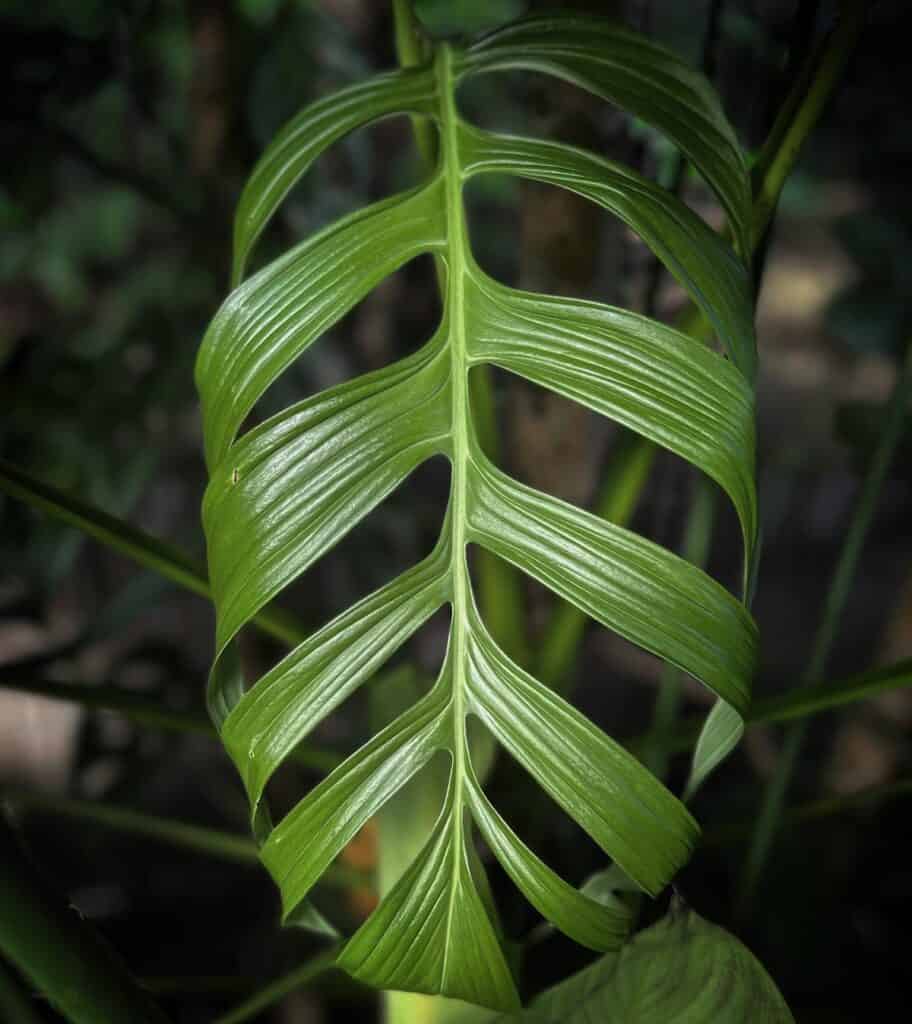
Monstera aureopinnata is a tropical, climbing plant that is native to SE. Colombia to N. Peru. This large shrub grows 5-10 ft tall and prefers semi-shade. It is quite hardy, being capable of surviving in USDA Zone 9-11. Without much effort in the form of pruning, this hardy plant develops impressive aerial roots and a full, lush canopy. With regular water and moderate fertilization, Monstera aureopinnata will thrive in almost any garden.
Monstera aureopinnata is an ideal choice for those who want the unmistakable leaf shape and foliage of the Monstera species, but don’t have the space for a full-sized vine or creeper. It’s easy to cultivate, and with minimal effort can look great even in cold regions.
When planting Monstera aureopinnata, it is important to ensure that the soil is light and well-draining to prevent root rot. The soil should also be kept moist, although not wet, with regular waterings and monthly fertilization. As this is a fast-growing plant, it will need to be repotted at least once every few years to provide sufficient space for its roots to grow.
Monstera barrieri
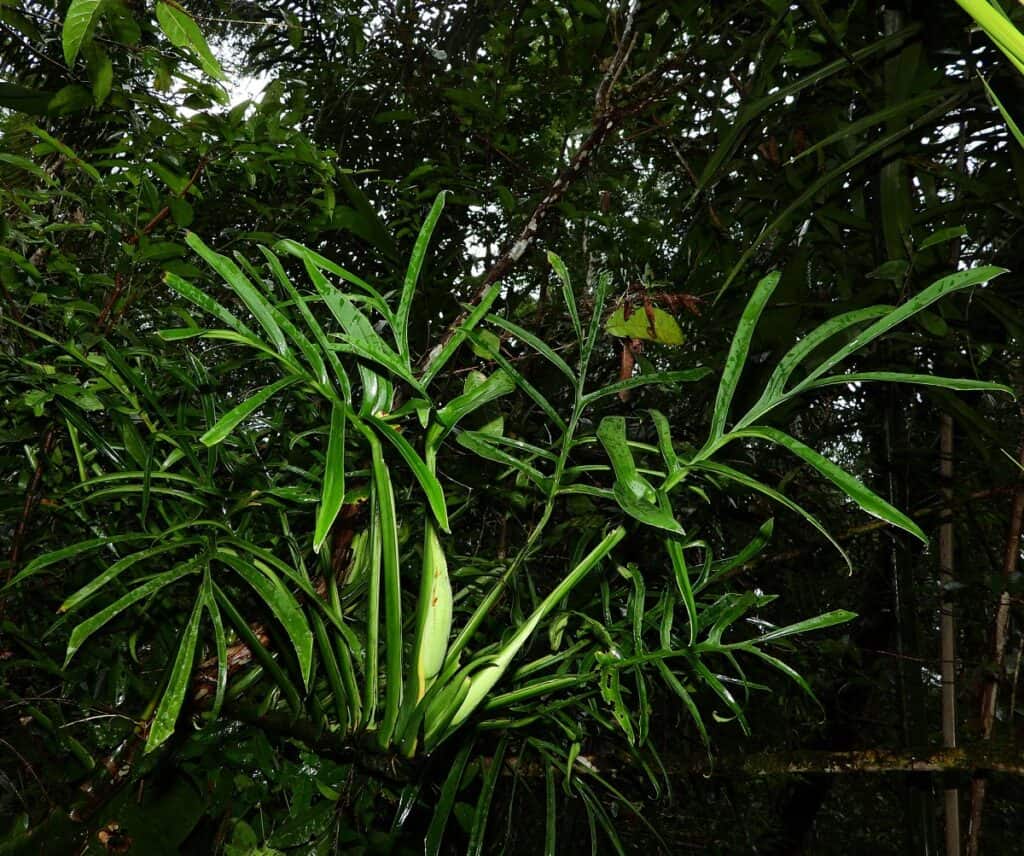
Monstera barrieri is an extremely rare and enigmatic species of tropical plant that is native to French Guiana. Unlike most other Monstera species, barrieri has a unique growth habit of shingling in an upward fashion.
The leaves of the plant are thick and velvety when it is young, but as it matures, it begins to develop fenestrations, which is a characteristic of many Monstera species. The fenestrations on Monstera barrieri are dramatic, with a more jagged and structured shape compared to other species such as M. subpinnata.
This species of Monstera is not commonly found in cultivation, and not much is known about its growth habit and requirements. It is important to note that Monstera barrieri is extremely rare and is considered a highly sought-after plant among collectors and enthusiasts.
Monstera borsigiana

Monstera ‘Burle Marx Flame’
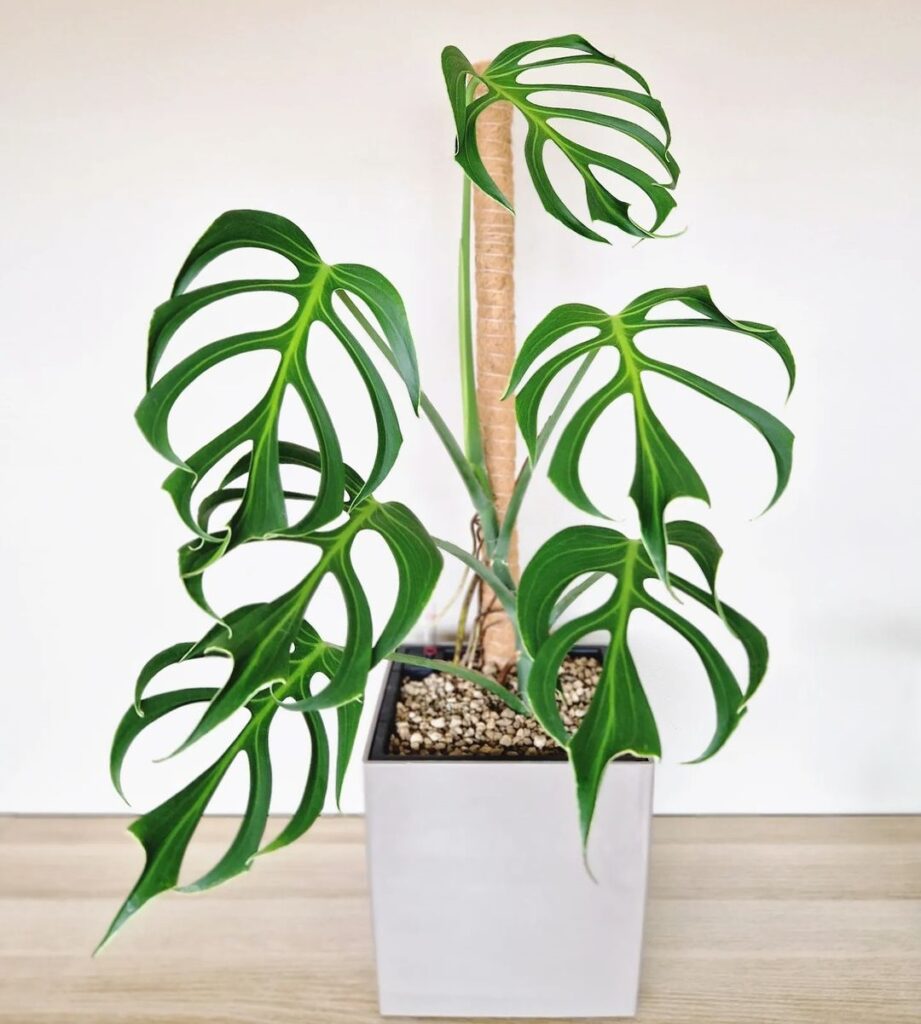
Also known as Monstera deliciosa Form 8, Monstera ‘Burle Marx Flame’ is a unique plant that was discovered in the collection of Burle Marx, a well-known Brazilian artist and landscaper, in Rio de Janeiro. Its exact origin is unknown, but it bears some resemblance to Monstera deliciosa, especially the variety Monstera deliciosa var. sierrana. The name ‘Burle Marx Flame’ comes from the fact that it was found in Burle Marx’s collection and its young leaves look like flames.
This plant is an active climber, meaning it likes to grow upward by clinging to structures like trees or trellises. It has spaces between where its leaves grow on the stem, known as internodes, which are moderately spaced apart. When the plant starts growing, its leaves are whole and undivided. As it matures, these leaves split into parts called leaflets, which are set wide apart from each other. Occasionally, you might notice holes at the base of some leaflets along the midrib.
The most distinguishing feature of Monstera ‘Burle Marx Flame’ is its narrow leaflets that are widely spaced apart, making it easy to tell apart from other similar Monstera deliciosa forms in cultivation.
Monstera buseyi
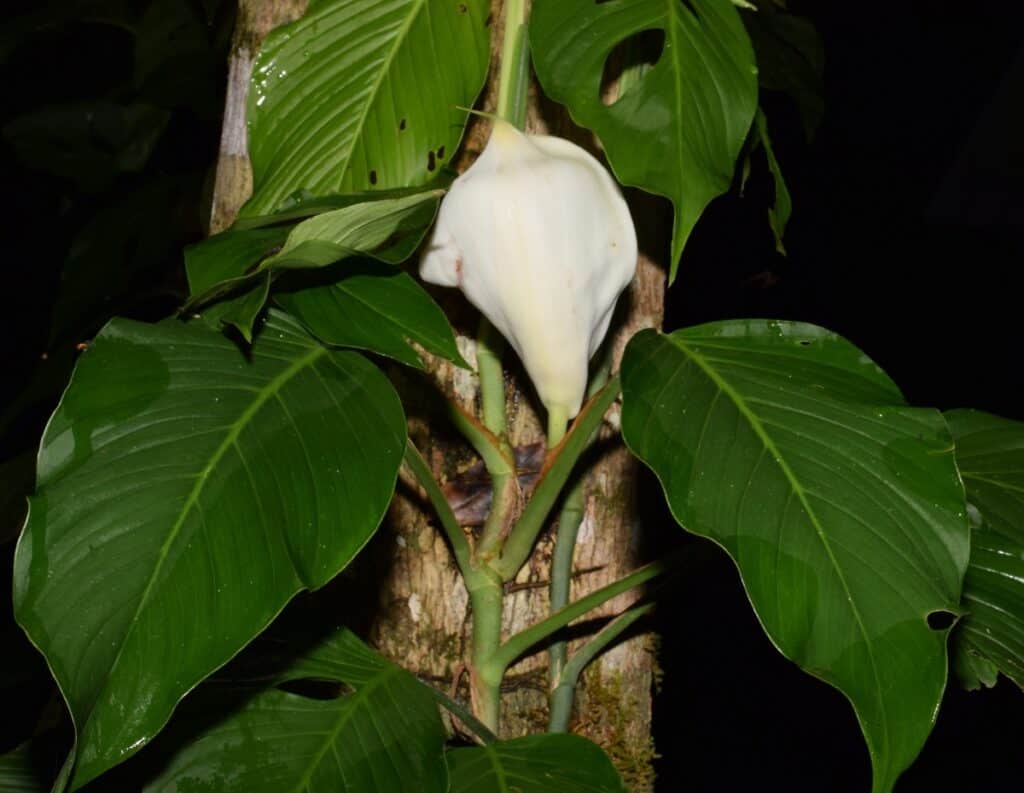
Monstera buseyi is a species of tropical climbing plant that is native to Costa Rica to SW. Panama. It is a member of the araceae family and is known for its large, glossy green leaves with perforations along the edges. The leaves are typically oval-shaped and as the plant matures, the leaves become larger and develop perforations along the edges, giving them a unique appearance similar to that of Swiss cheese.
The plant is not commonly found in cultivation, and not much is known about its growth habits and requirements. It is considered a rare plant among collectors and enthusiasts.
Monstera costaricensis
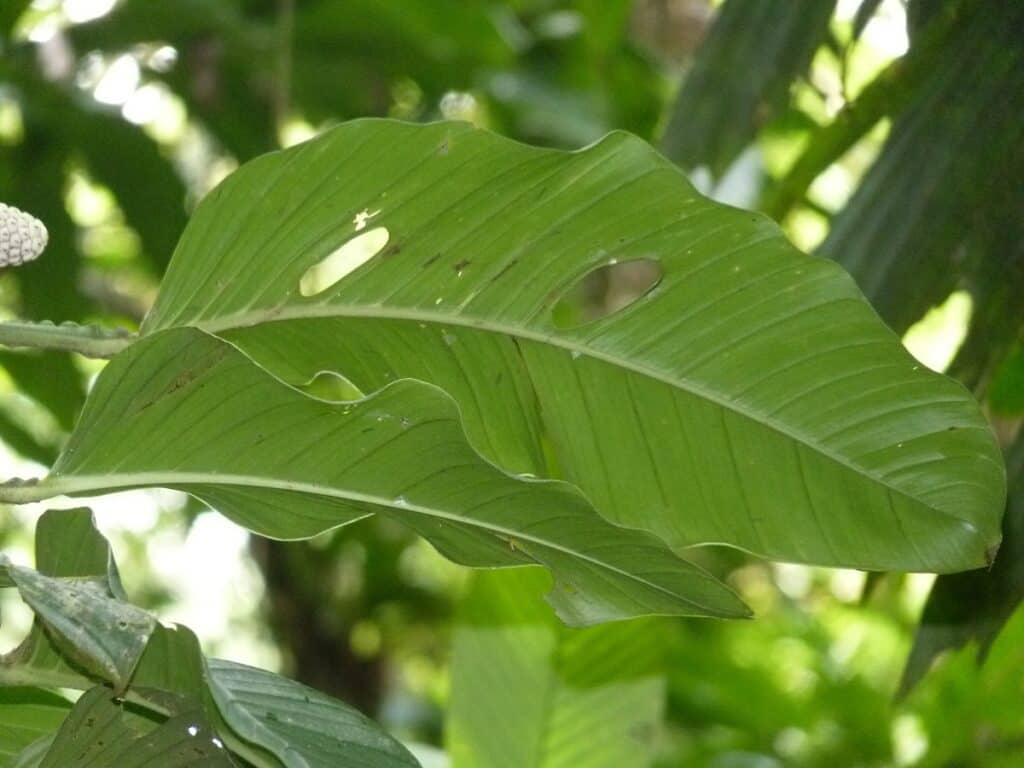
Monstera costaricensis is a tropical, climbing plant that is native to Costa Rica. It is a member of the Araceae family and is known for its glossy green leaves with perforations along the edges.
This species of Monstera is not commonly found in cultivation and not much is known about its growth habits and requirements. Due to its limited distribution and rarity, little is known about the plant’s natural habitat, ecology and its specific needs to thrive in cultivation.
Monstera croatii
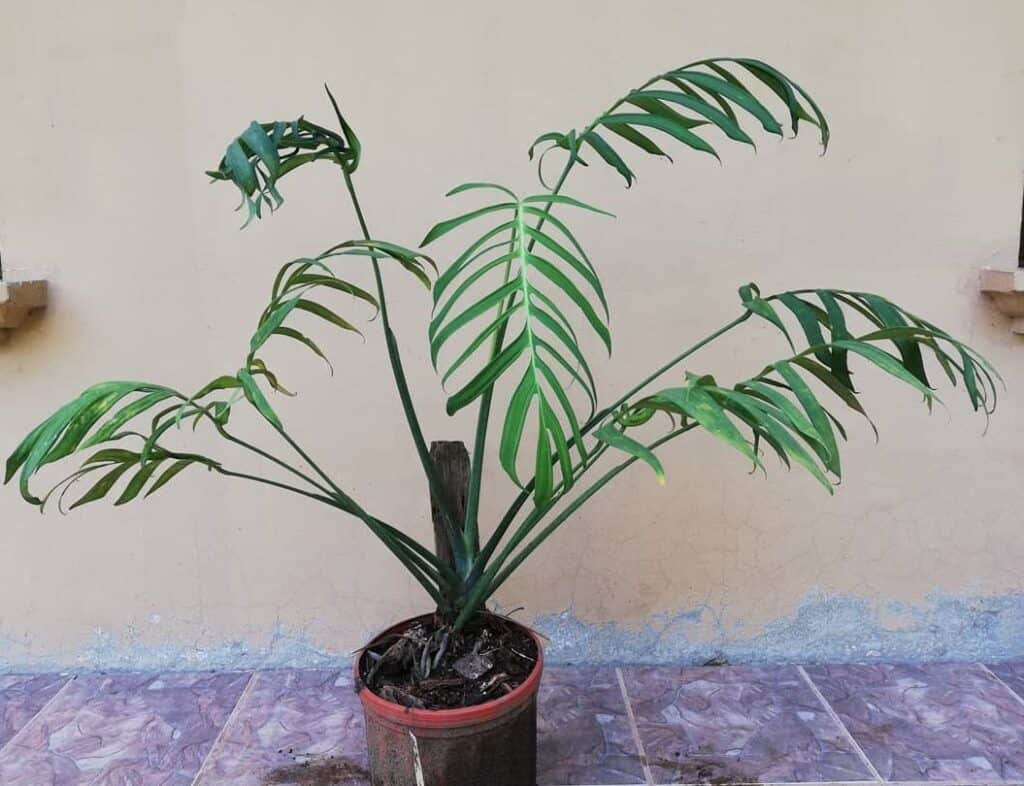
Monstera croatii is a newly discovered species of tropical climbing plant that is native to Costa Rica. It belongs to the Araceae family and is known for its elegant, fenestrated leaves. As the plant matures, the fenestration, or the perforations, on the leaves extends to the ends of the leaves, which is a very unique characteristic for a Monstera species.
Like most Monstera varieties, this plant prefers moist but well-draining soil and some humidity. It is a climbing plant and should be staked or allowed to climb up moss poles. In higher humidity environments, numerous aerial roots will form, which gives the plant a beautiful look.
Monstera croatii is a relatively new species, and not much is known about its growth habits and requirements. However, it is considered a highly sought-after plant among collectors and enthusiasts due to its unique leaf characteristics. It is relatively rare, and it is not commonly found in cultivation.
Monstera deliciosa
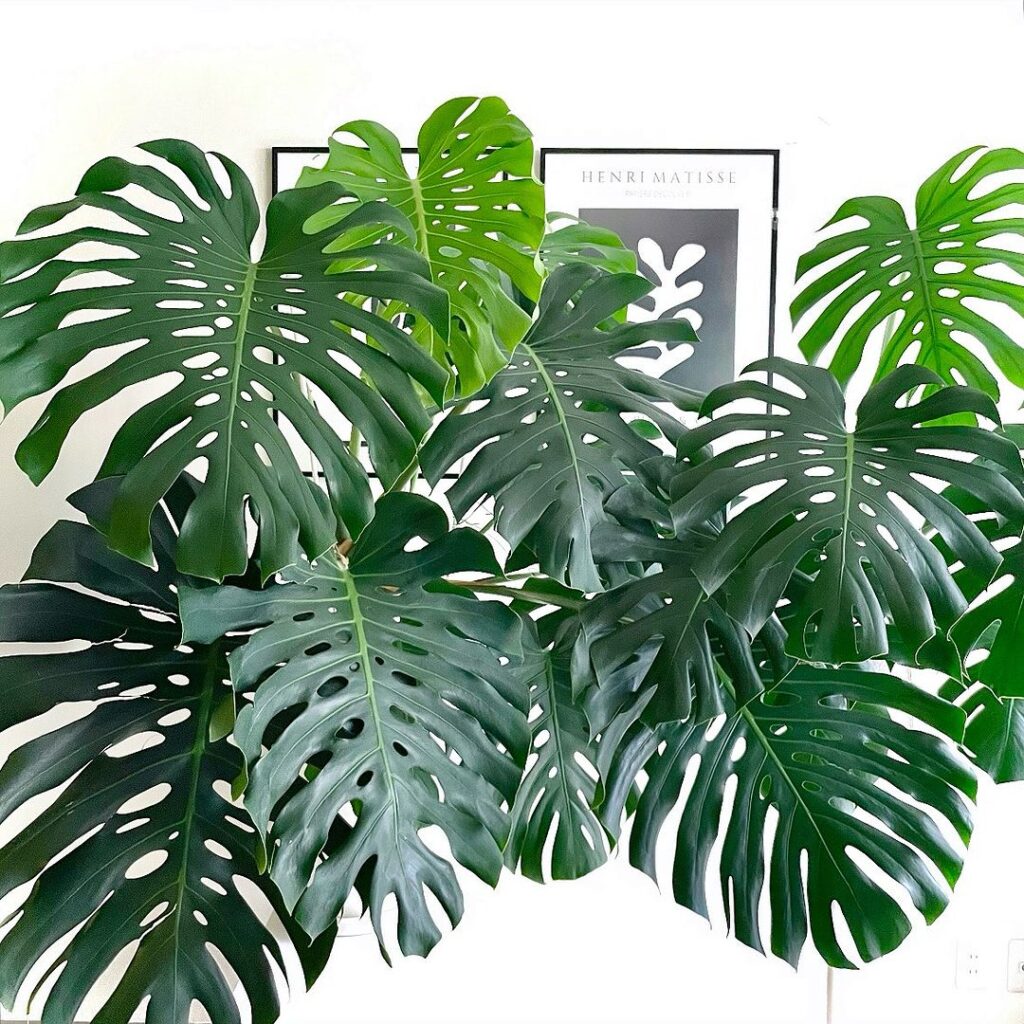
Monstera deliciosa, also known as the Swiss cheese plant or split-leaf philodendron, is a species of flowering plant native to tropical forests of southern Mexico, south to Panama. It is a woody, perennial, broad-leaved evergreen, climbing vine that belongs to the Araceae (arum) family.
In its native habitat, it starts its life as a terrestrial plant, turning epiphytic once it comes into contact with a sturdy tree it can climb. It can grow to 70 feet tall in the wild, but it typically stays between 6 to 8 feet in most home environments.
The leaves are large and glossy, with perforations along the edges, giving them a unique appearance similar to that of Swiss cheese. It typically does not produce flowers or fruits in interior landscapes but it can produce an edible fruit that is said to taste like a cross between a banana and pineapple in its natural habitat.
Monstera deliciosa is a popular houseplant and is known for its ability to thrive in a wide range of conditions. It prefers bright, indirect light and well-draining soil. It is a fast-growing plant and will need to be repotted regularly to provide sufficient space for its roots to grow.
Monstera deliciosa Form 6
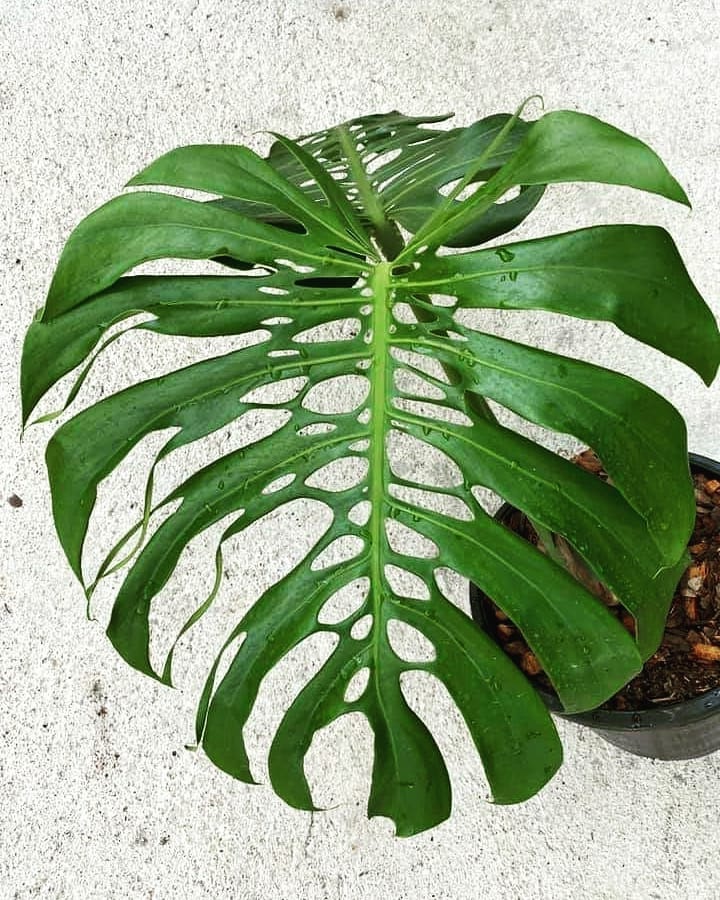
Monstera deliciosa Form 7
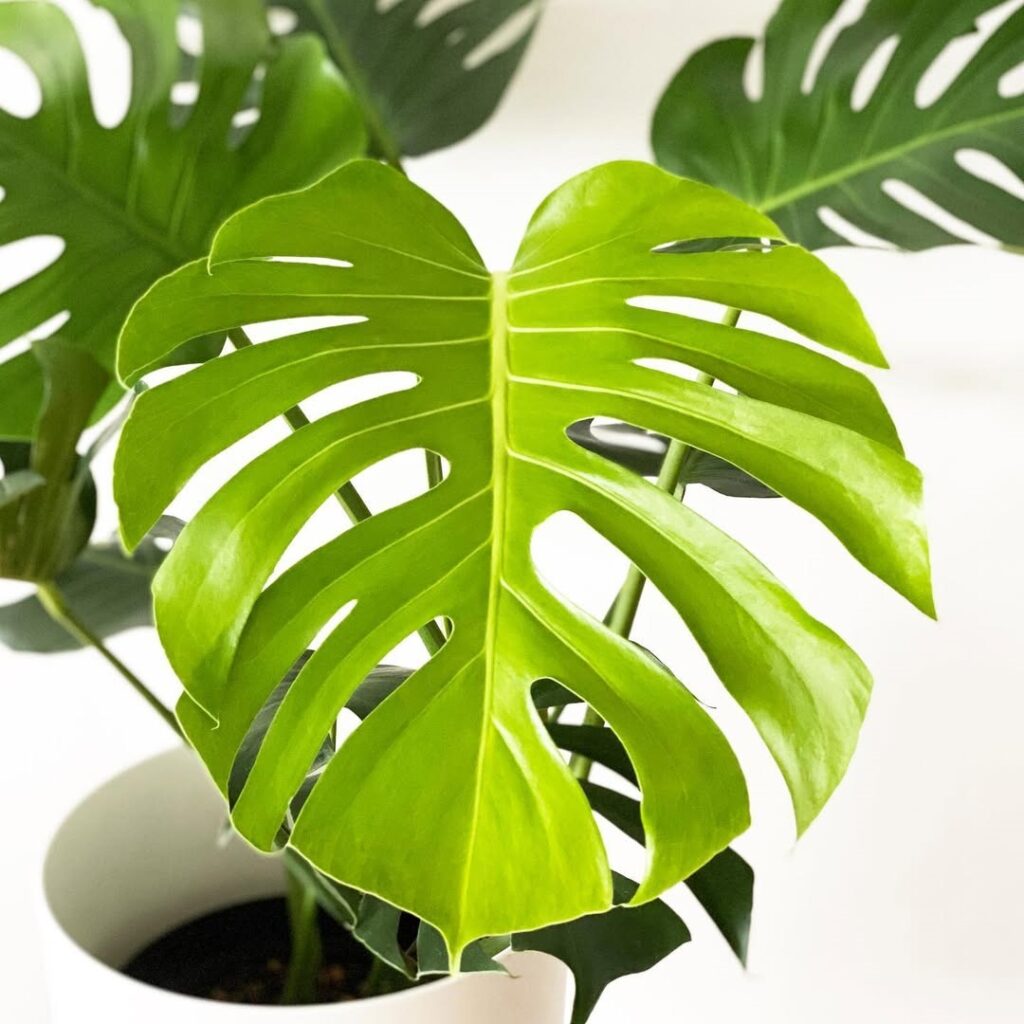
Monstera deliciosa Form 7 is a fascinating variant that falls somewhere between Monstera deliciosa and Monstera deliciosa f. borsigiana. Its internodes, which are the spaces between where the leaves grow on the stem, are not as closely set as in the typical Monstera deliciosa but not as far apart as in the borsigiana form. This unique spacing gives Form 7 a distinct appearance.
The leaves of Monstera deliciosa Form 7 are noted for their roundness and wider spaced fenestration, which refers to the natural holes and splits in the leaves. This fenestration pattern gives the leaves an almost skeletal look, but with a touch of elegance and fullness that sets them apart from other Monstera varieties.
Monstera deliciosa ‘Thai Constellation’

Monstera deliciosa ‘Thai Constellation’ is a stunning variegated cultivar of Monstera deliciosa, known for its unique foliage pattern resembling a starry sky. This plant has become highly sought after by houseplant enthusiasts for its decorative appeal and relatively easy care. The large, glossy leaves feature a distinctive variegation pattern of creamy-white to yellow spots and splashes across deep green foliage, making each leaf a unique piece of natural art.
Native to the tropical forests of southern Mexico to Panama, Monstera deliciosa thrives in the understory with dappled sunlight, which makes it well-suited for indoor conditions. The ‘Thai Constellation’ cultivar, like its parent species, is a tropical, evergreen shrub with a climbing habit. It produces long aerial roots that seek support, allowing it to climb trees and other structures in its natural habitat or trellises and poles when cultivated indoors.
Indoors, ‘Thai Constellation’ can grow 6-15 feet tall and 4-5 feet wide, depending on the support provided. Its growth rate is somewhat slower than the non-variegated Monstera deliciosa due to reduced chlorophyll in the variegated sections of its leaves. The foliage is truly remarkable, with large, glossy leaves splattered with creamy-white to yellow variegation, resembling a constellation against a dark green sky. As the leaves mature, they develop characteristic splits and holes, further adding to the plant’s exotic and lush appearance, making it a standout specimen in any indoor plant collection.
Monstera deliciosa ‘Yellow Marilyn’
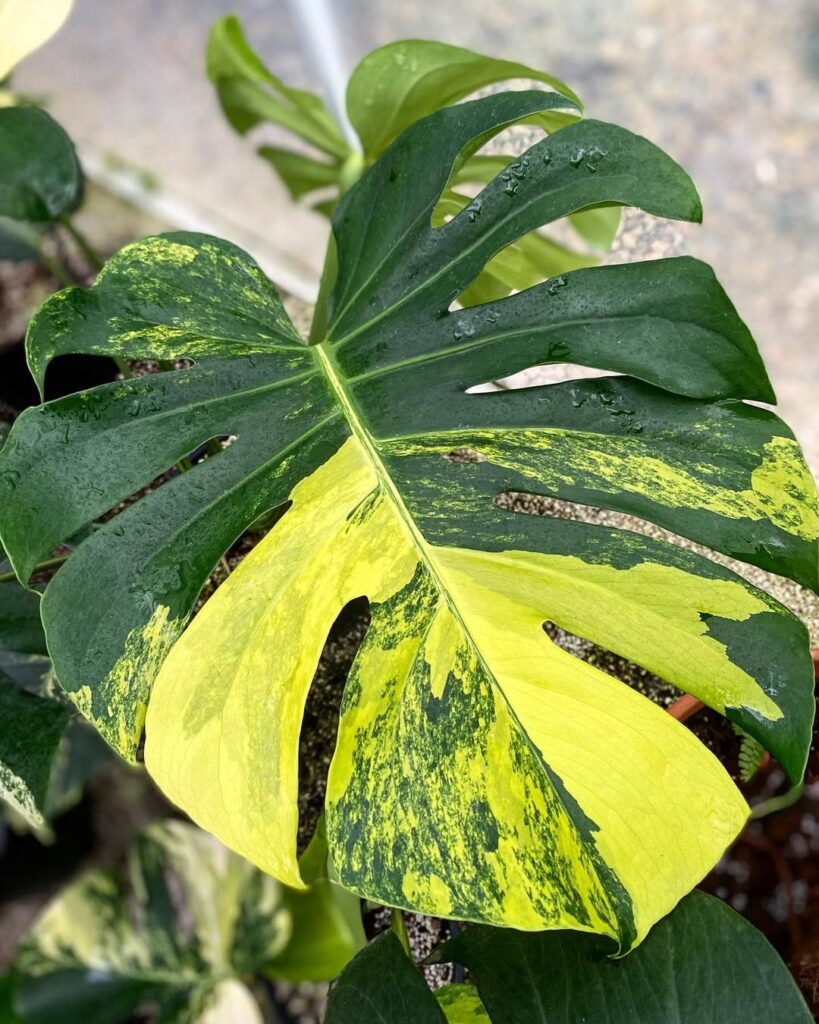
Monstera deliciosa ‘Yellow Marilyn’ is a captivating variant known for its striking yellow variegation. One of its most intriguing aspects is its color transformation process. The young leaves emerge with a yellow-green variegation, gradually intensifying into bright yellow tones. As they mature, the leaves adopt a creamy or white-yellow hue, adding depth and elegance to the plant’s appearance.
Environmental factors play a crucial role in shaping the coloration of ‘Yellow Marilyn.’ Light intensity, temperature, humidity levels, and nutrient availability all influence the vibrancy and stability of its yellow variegation. Proper care and maintenance, tailored to its specific needs, are essential for preserving its distinct coloration. Originating from Mr. Kunzo, a seasoned plant enthusiast in Japan, ‘Yellow Marilyn’ has gained worldwide attention from plant lovers.
This variant exhibits Polaroid variegation, where the leaf color transitions from green to yellow. Young leaves display a mesmerizing blend of green and pale yellow hues, with the yellow variegation becoming more prominent over time. Eventually, the leaves mature into vibrant shades of yellow and then to a soft cream or white-yellow color, making ‘Yellow Marilyn’ a sought-after addition to indoor plant collections.
Monstera dissecta
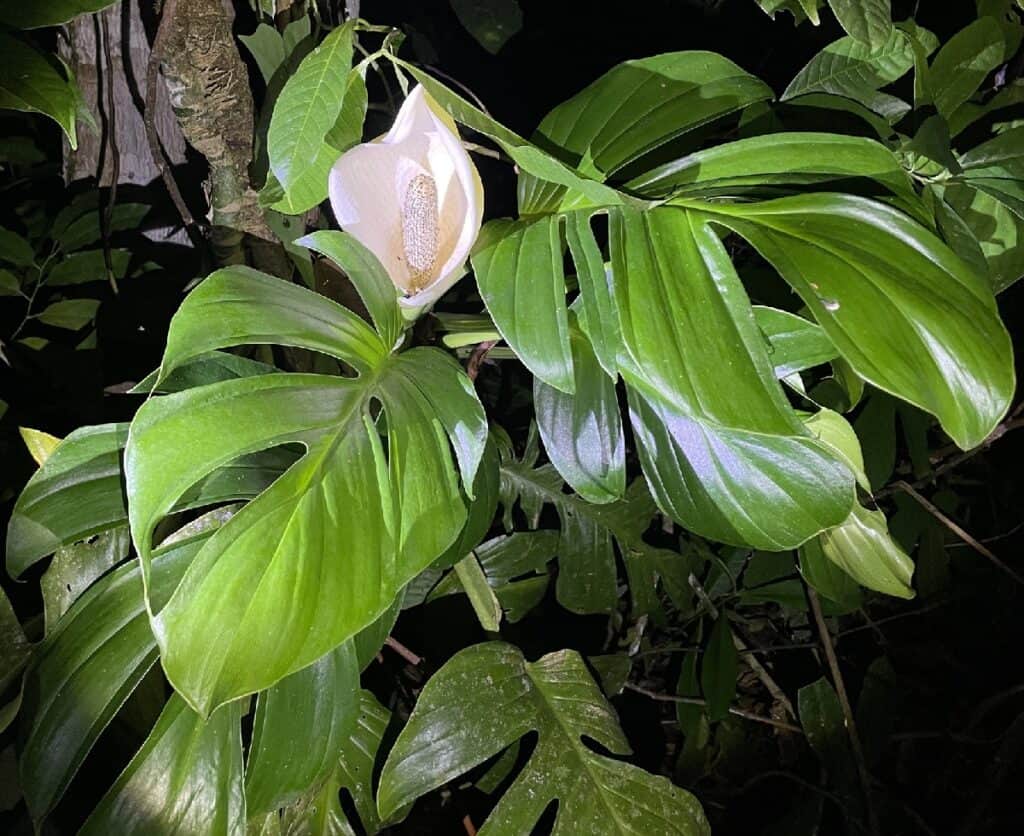
Monstera dissecta is a very rare or uncommon tropical climbing plant that is native to Belize, Colombia, Guatemala, Costa Rica, Honduras, Panama, Nicaragua, Peru, and North Brazil.
It is known for its unique leaf characteristics, where the juvenile plant has entire, oval to lance-shaped, leathery, and glossy green leaves. As the plant matures, the leaves become larger and pinnatifid (split), forming a tight cluster at the stem top. The leaves also have petiole with sheaths and their sheath wings that persist and don’t dry and fall.
In its natural habitat, Monstera dissecta can grow up to about 32 feet (10m) long, but it will reach about 4 to 8 feet as a houseplant. It needs a place to climb and grow.
The plant also produces small, white inflorescence flowers that are borne on a spadix and surrounded by a white spathe. The flower’s stalk is slightly longer than the spadix by about 0.4 inches.
Monstera dubia
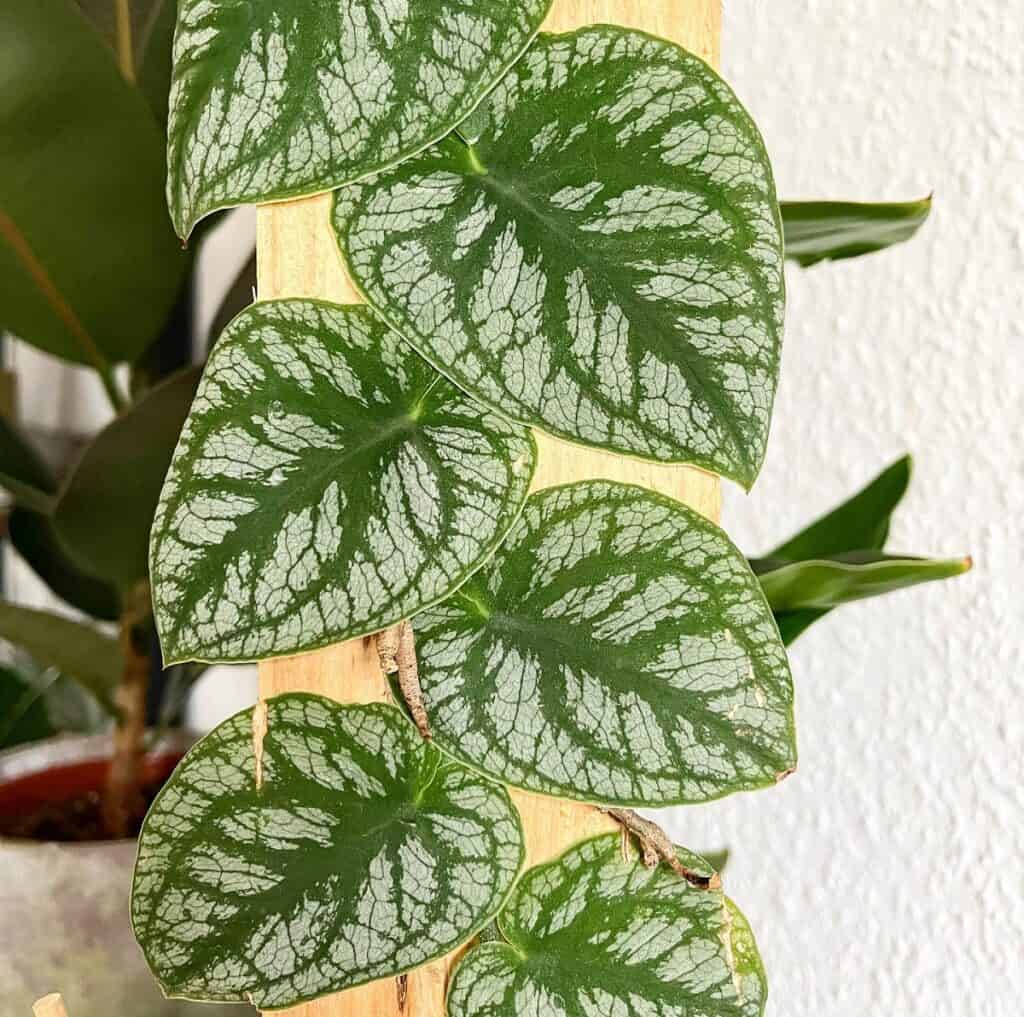
Monstera dubia is a smaller and lesser-known variety of the monstera plant family. It is known for its unique leaf characteristics, which are small and heart-shaped with speckles of light and dark green. These leaves are characteristic of the juvenile stage of the plant, which is typically the stage seen indoors.
Unlike other monstera varieties, Monstera dubia does not have the iconic slits and holes in its leaves, known as fenestration, which makes it easily recognizable as a monstera. However, the beautiful light and dark green patterned leaves make this a beautiful plant in its own right.
One interesting fact about Monstera dubia is that it is sometimes called the “shingle plant” because its leaves lie so flat against the trees it climbs in the wild, creating the appearance of shingles.
This plant is ideal for collectors and enthusiasts of monstera plants and makes a great addition to any houseplant collection. It prefers moist but well-draining soil and some humidity, and should be staked or allowed to climb up moss poles.
Monstera egregia
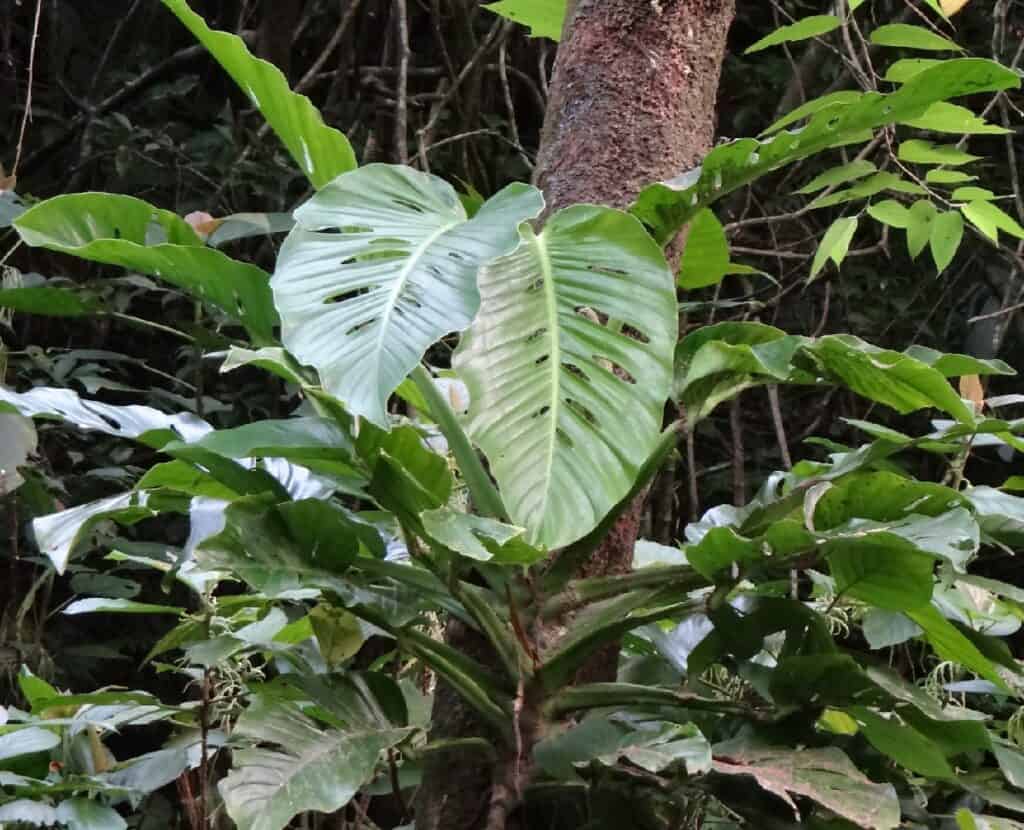
Monstera egregia is a species of flowering plant that is considered rare, and not much is known about its growth habits and requirements. The information available is limited to its native range, Central and South Mexico to Belize.
Monstera epipremnoides
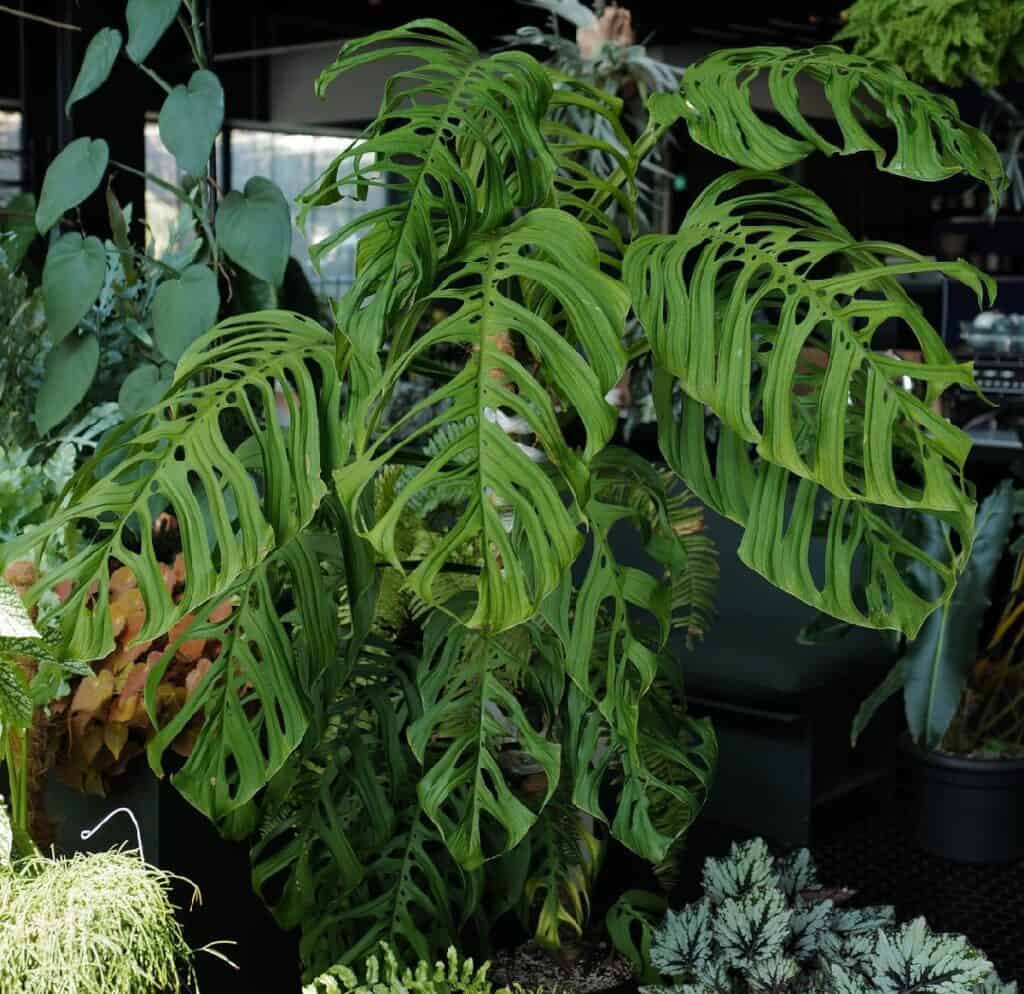
Monstera epipremnoides, also known as Monstera esqueleto, is a tropical evergreen vine that is native to Central and South America. It is known for its large leaves that resemble Swiss cheese, with holes and perforations that appear as the leaves mature. The shape of the leaves also changes from entire to pinnatifid as they mature. It can grow up to 13 feet tall in its natural habitat.
This plant is not tolerant of direct sunlight and wet soil. It prefers moderate light and average humidity, making it well-suited for indoor environments. To thrive, it needs rich, well-drained soil that is not allowed to dry out completely, a soilless recipe works well. This plant can be easily propagated by cuttings. It has no serious pest or disease problems.
Monstera filamentosa
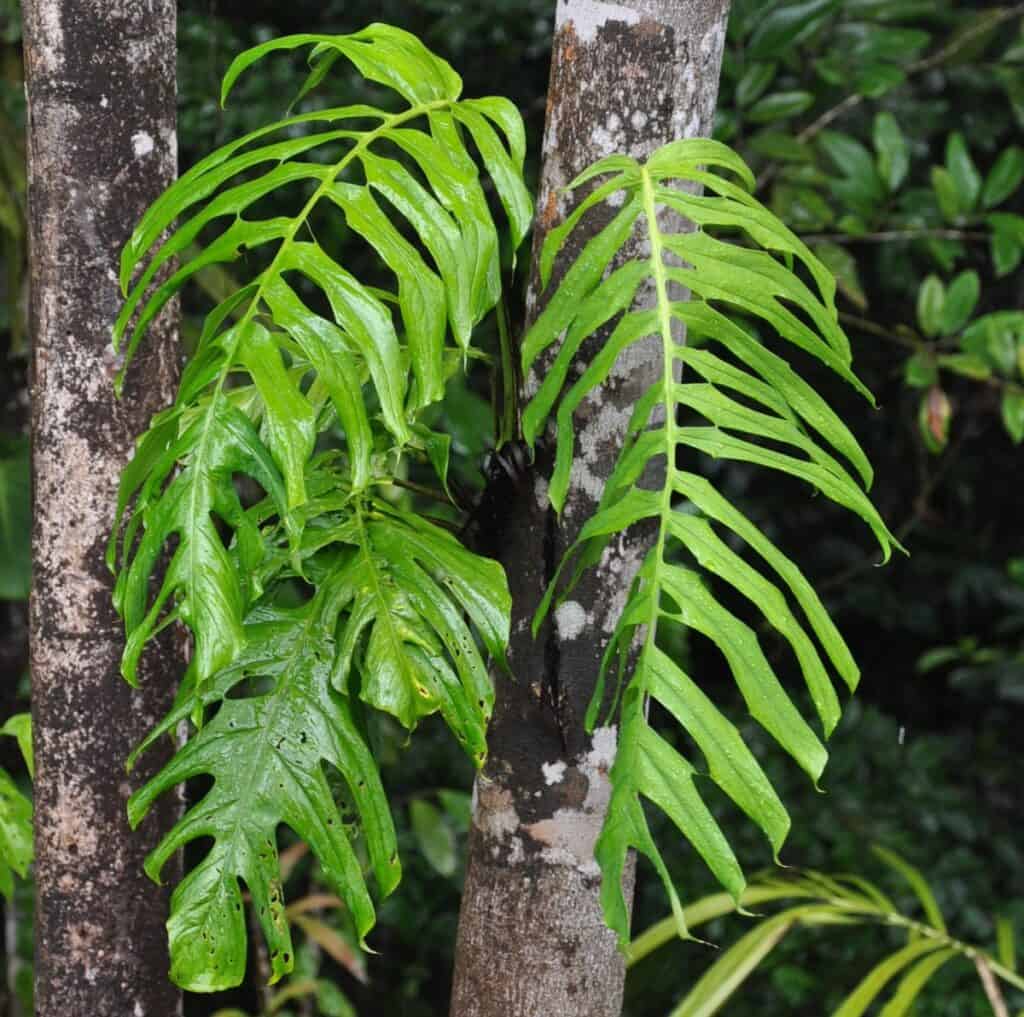
Monstera filamentosa is a species of the Monstera genus that is known for its highly fenestrated leaves. It is a tropical, climbing plant that is part of the Araceae family.
In its natural habitat, it can grow up to several feet tall and wide, using aerial roots to climb on trees and other surfaces. The leaves of the Monstera filamentosa are typically glossy green, and as the plant matures, the leaves become increasingly pinnatifid, giving them a unique and striking appearance.
In cultivation, it is a relatively easy plant to grow, but it does require a lot of space, as it can grow quite large. It can be propagated from stem cuttings, and it is not a common plant found in cultivation.
Monstera Ginny

Monstera Ginny, also known as the mini Monstera, mini split leaf, or philodendron ginnie, is botanically named Rhaphidophora Tetrasperma. While it closely resembles the Monstera deliciosa plant, there are notable differences between the two. Rhaphidophora Tetrasperma typically has smaller leaves and a more compact growth habit, making it an ideal choice for smaller spaces. The leaves feature distinct splits and a lush green color, contributing to its popularity among houseplant enthusiasts who appreciate its miniature, yet striking, appearance.
Monstera glaucescens
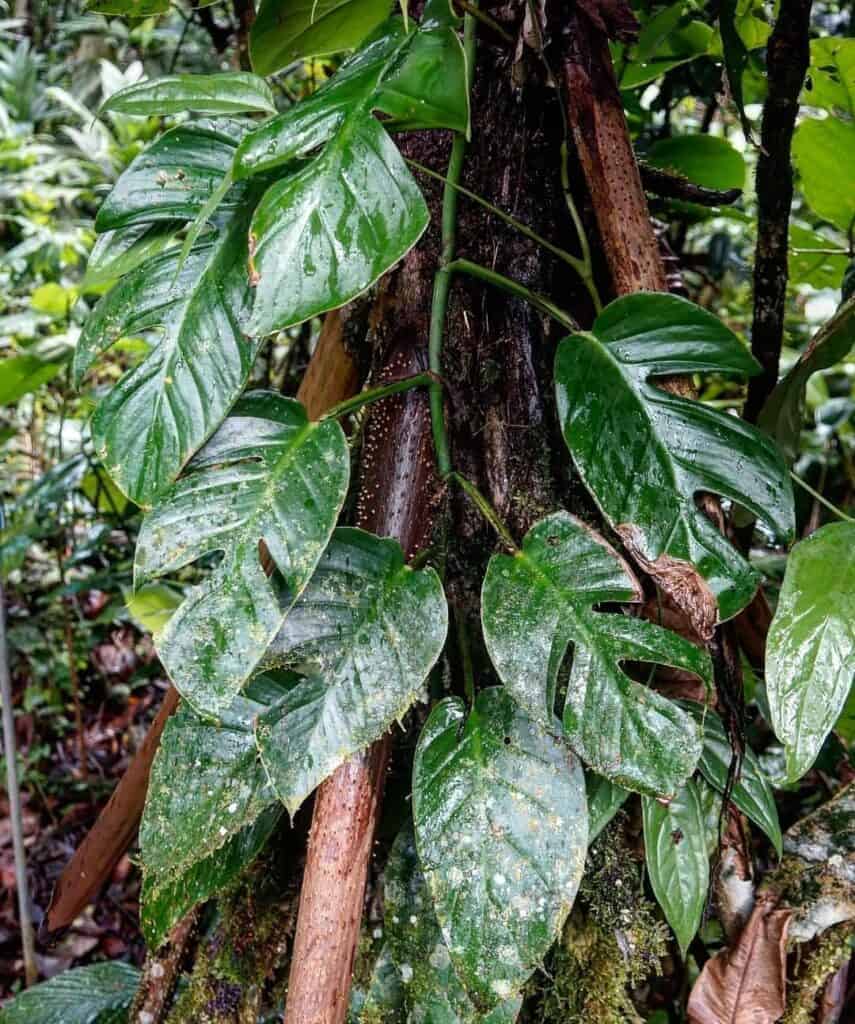
Monstera glaucescens is a species of the Monstera genus that is native to Southeast Nicaragua to Western Colombia. It is a tropical, climbing plant that is part of the Araceae family. It is a rare species in cultivation and it is known for its highly fenestrated leaves.
Monstera gracilis
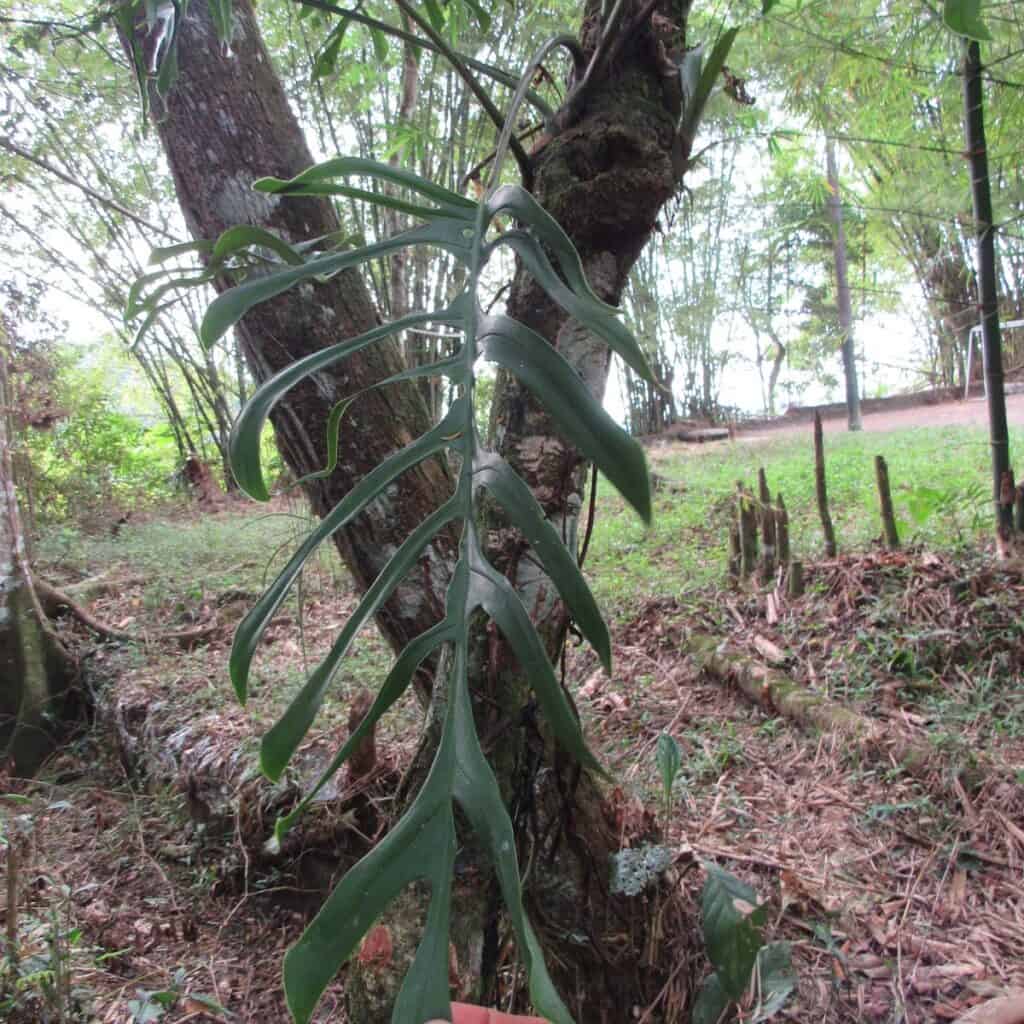
Monstera gracilis is a rare species of flowering plant that is native to eastern Colombia. It is known for its limited geographic range and its small population size. The plant is a climbing species, but it does not climb very high and is known for its stolons that return to the ground.
It is distinguished from other species of Monstera by its membranaceous leaves, deciduous petiole sheath wings, and smaller spadices and slenderer stems. In comparison to other species like M. dissecta and M. adansonii, it has smaller spathe and spadix and pinnatifid leaves. It is found in riparian forest in the llanos.
Monstera guzmanjacobiae

Monstera guzmanjacobiae is a rare, hemiepiphytic plant that is endemic to the Los Tuxtlas region in Mexico. The plant has a unique growing habit, it is appressed-climbing and ultimately pendent. The juvenile plants have stem that are terete, light green and smooth with internodes of 4-8 cm and leaves that are completely adhering to the surface of the phorophyte and are obovate without fenestrations.
As it matures, the stem becomes dark green, semiglossy and has few greenish pustules. The leaves are ovate to widely elliptic and can be chartaceous or thinly coriaceous. The adult plant has inflorcences that are axillary and often solitary.
Monstera integrifolia
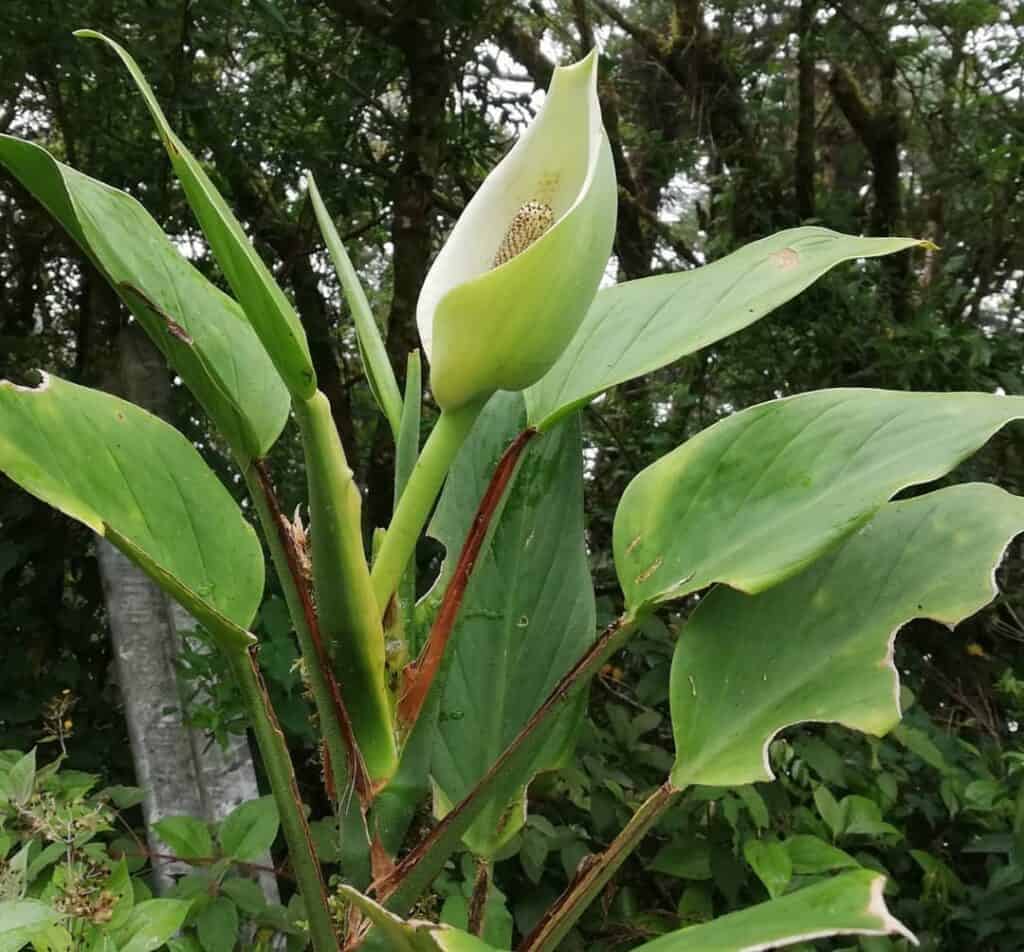
Unfortunately, there is not much information available about the specific characteristics of Monstera integrifolia. It is known that it is native to Central America, specifically Costa Rica to Panama.
Monstera juliusii
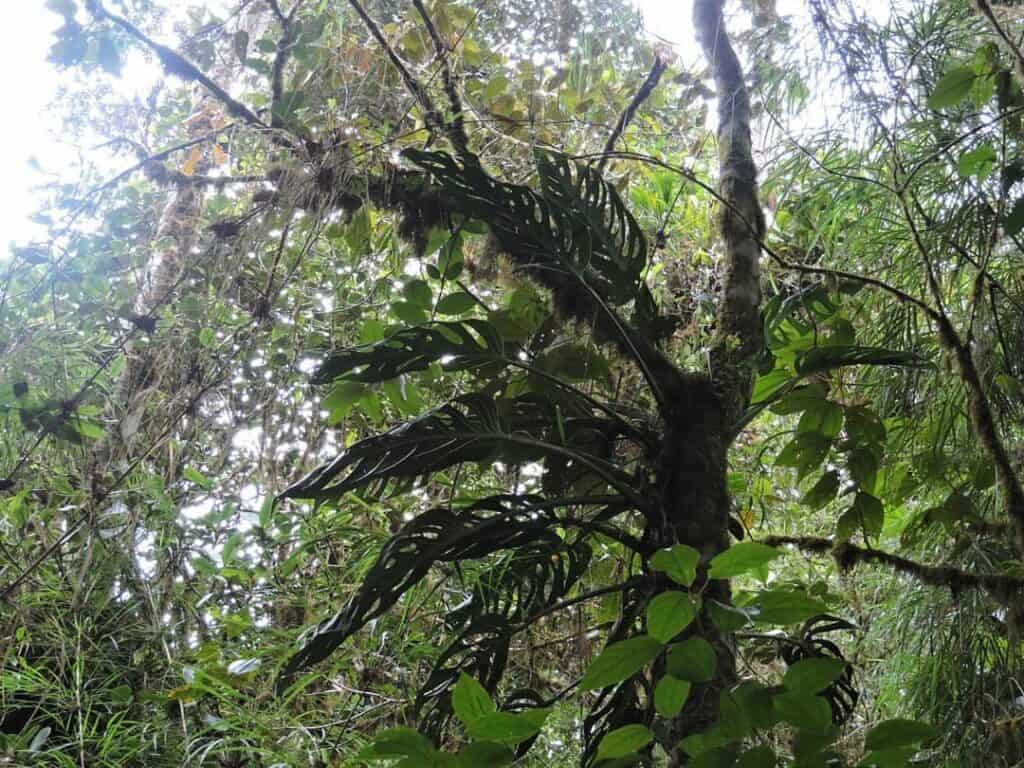
Monstera juliusii is a rare tropical climbing plant that is native to the southern Costa Rican portion of the Cordillera de Talamanca at elevations of 1600-2250 m. It is characterized by having unique features such as white-green or mottled petioles which are sheathed along their entire length, thick and persistent sheath, leaves that are fenestrated, entire or partially pinnatilobed and spathes that are yellowish-green on the outside and white on the inside. It has been mistaken for M. standleyana in herbaria.
Monstera karstenianum
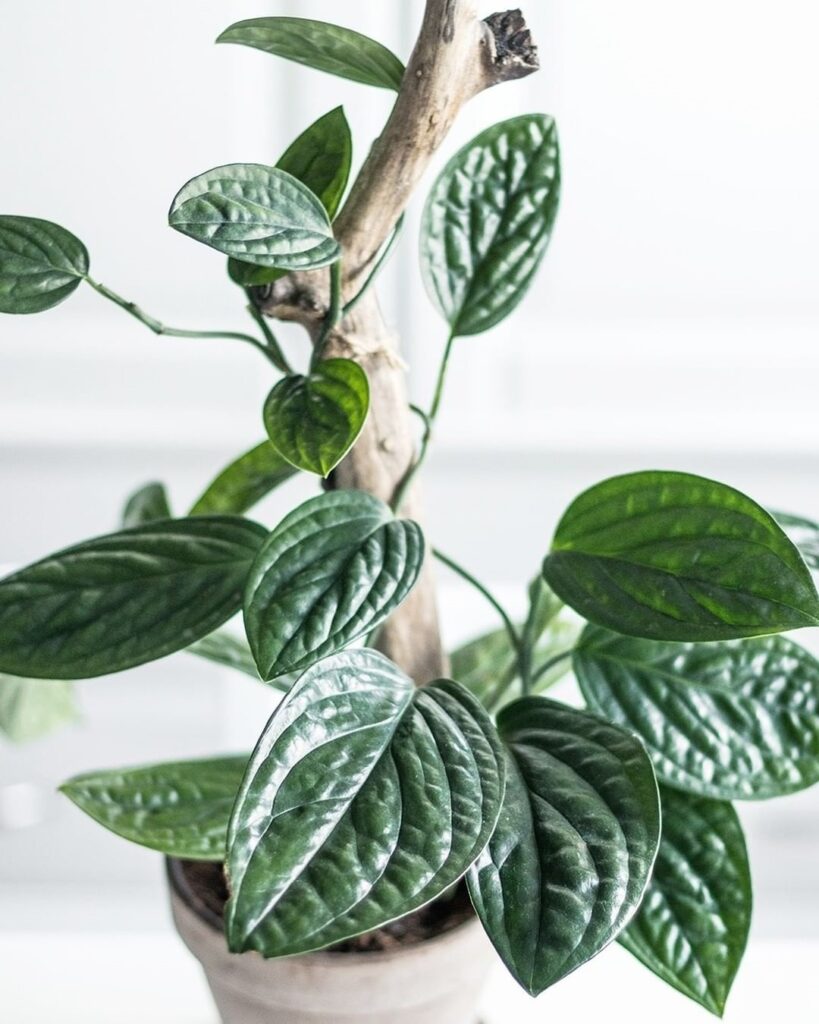
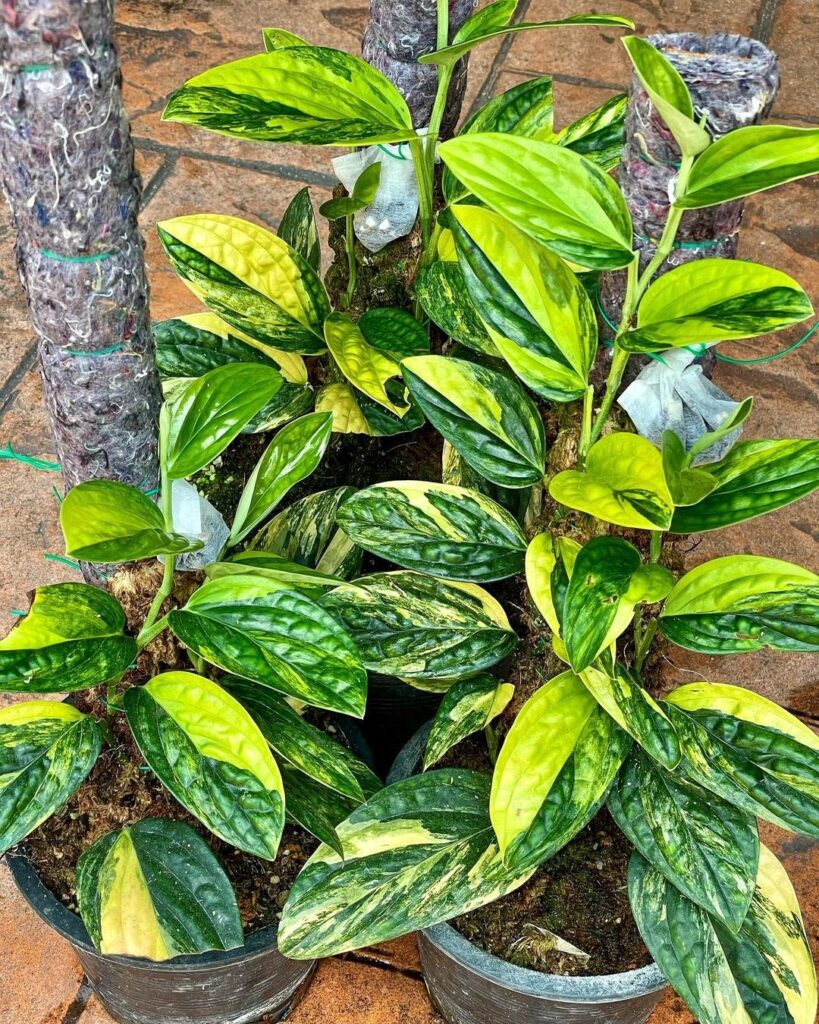
Monstera karstenianum, also known as Monstera Peru, is a captivating plant admired for its glossy, textured leaves adorned with deep ridges and a marbled pattern of green shades that can appear almost metallic in the right light. This species is often mistaken for a type of Philodendron due to its vining habit and leaf texture. Native to the tropical forests of Central and South America, Monstera karstenianum thrives under the canopy of large trees, enjoying dappled sunlight and high humidity in its natural habitat.
As a tropical, evergreen climbing plant, Monstera Peru uses aerial roots to ascend the trunks of trees in the wild. In indoor settings, it can be encouraged to climb a moss pole or trellis or allowed to trail from a hanging basket. The plant typically reaches a manageable size indoors, growing around 6-8 feet in height and spreading 12-18 inches, depending on pot size, pruning practices, and support provided for climbing.
The most striking feature of Monstera karstenianum is its unique foliage. The leaves are relatively small compared to other Monstera species, making it suitable for smaller spaces. Each leaf is uniquely patterned with ridges and a mix of green hues, making it a distinctive and attractive choice for houseplant enthusiasts.
Monstera lechleriana
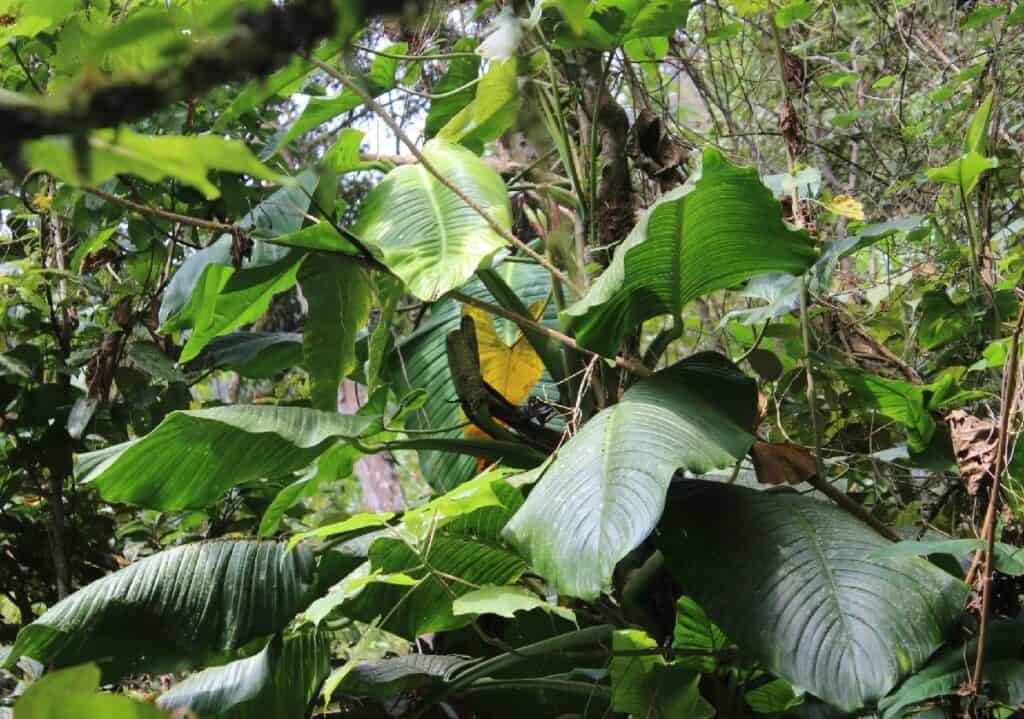
Monstera lechleriana is a species of tropical climbing plant in the genus Monstera and family Araceae. It is known for its highly fenestrated leaves, which develop holes as the plant matures. Young plants may not have any holes at all, which can make it difficult to identify them.
The leaves of a mature Monstera lechleriana can grow up to 10 inches long with rounded holes close to the central rib of the leaf. These plants prefer to climb and can grow up to 8 feet tall indoors if provided with a support such as a moss pole or trellis.
A variegated form of Monstera lechleriana is also known to exist, but it is extremely rare and expensive. These plants have a beautiful marbled white and dark-green variegation, but they can be harder to keep alive than their non-variegated counterparts due to their need for more sunlight and their sensitivity to direct sunlight.
Monstera lentii
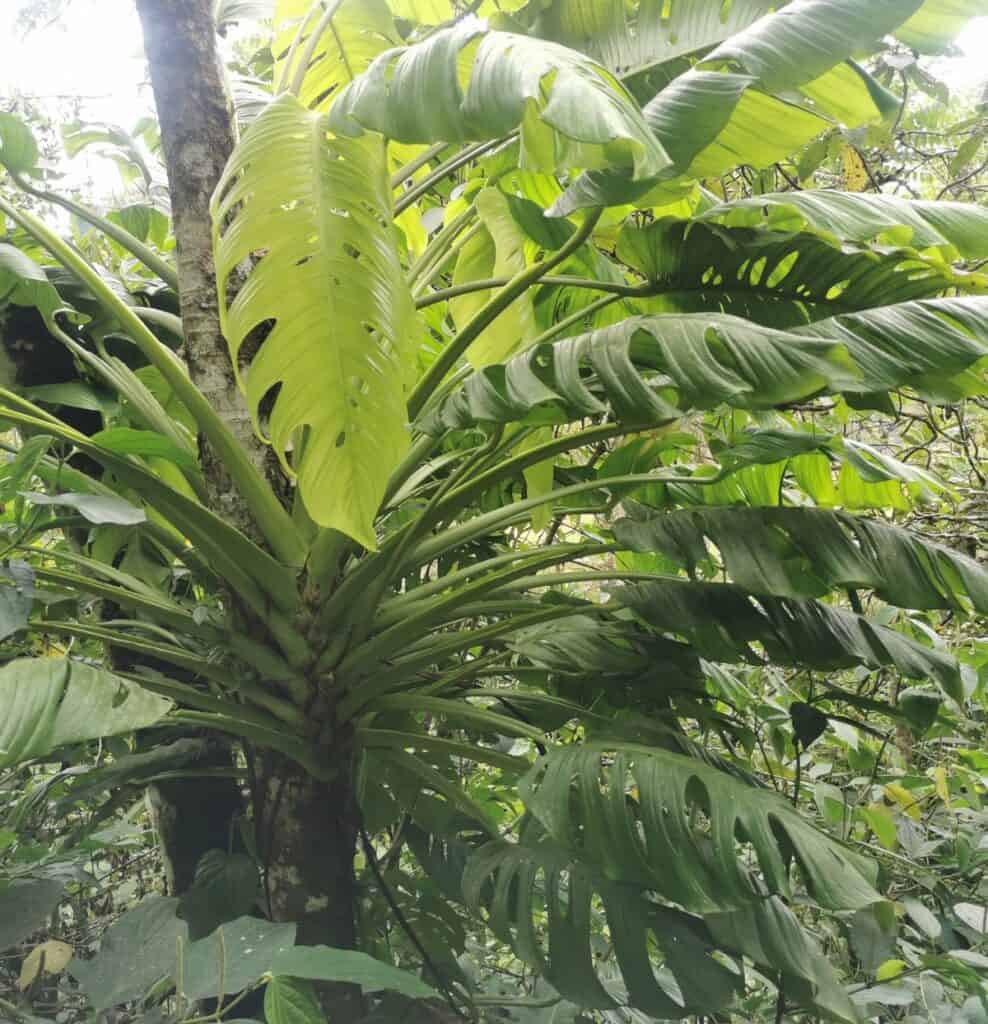
Monstera lentii is a species of flowering plant in the arum family, native to Costa Rica and western Panama. It belongs to the genus Monstera, which is known for its large, perforated leaves. Not much information is available about this specific species, as it is not well-studied or widely cultivated. However, it is likely that it grows primarily in the wet tropical biome of its native range, and may share similar characteristics with other Monstera species such as aerial roots and a climbing habit.
Monstera limitaris
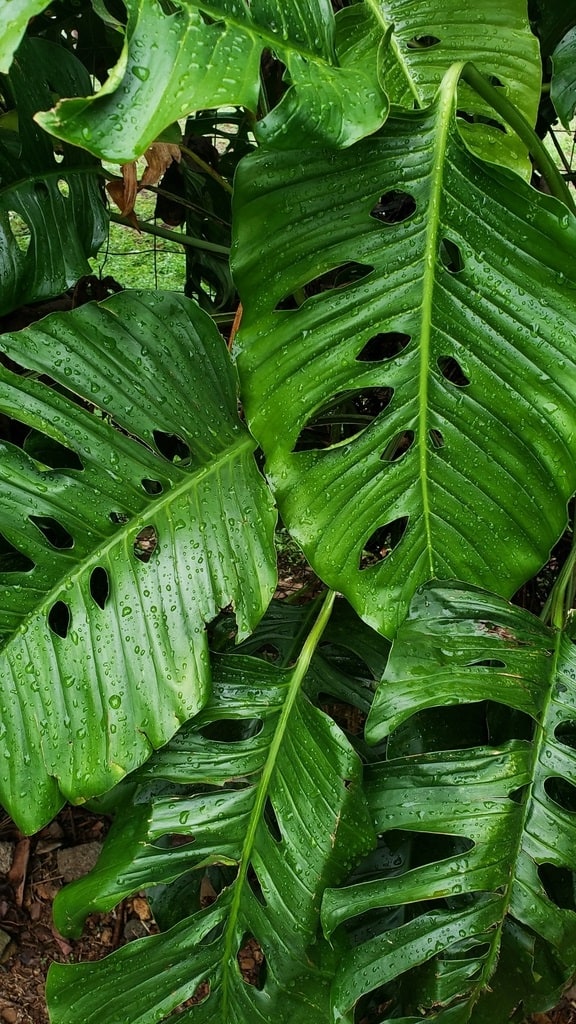
Monstera limitaris is a recently discovered species from the border between Costa Rica and Panama. It is known for its unique leaf characteristics, including verruculose (warty or bumpy) petioles at the base, semi-persistent and convolute (folded or rolled) sheaths, and crenate (toothed or scalloped) geniculum margins. The leaves of this species also have pinnatifid (deeply lobed or divided) margins and fenestrations (holes or perforations) along the midrib.
This species also has distinctive inflorescence characteristics, such as a white-yellowish acuminate (tapering to a point) spathe, a creamy-white spadix, and flowers with lateral-flattened stigmatophore (the part of the pistil that receives the pollen) and linear stigma (the receptive part of the pistil) which have a colorless stigmatic secretion.
Monstera membranacea
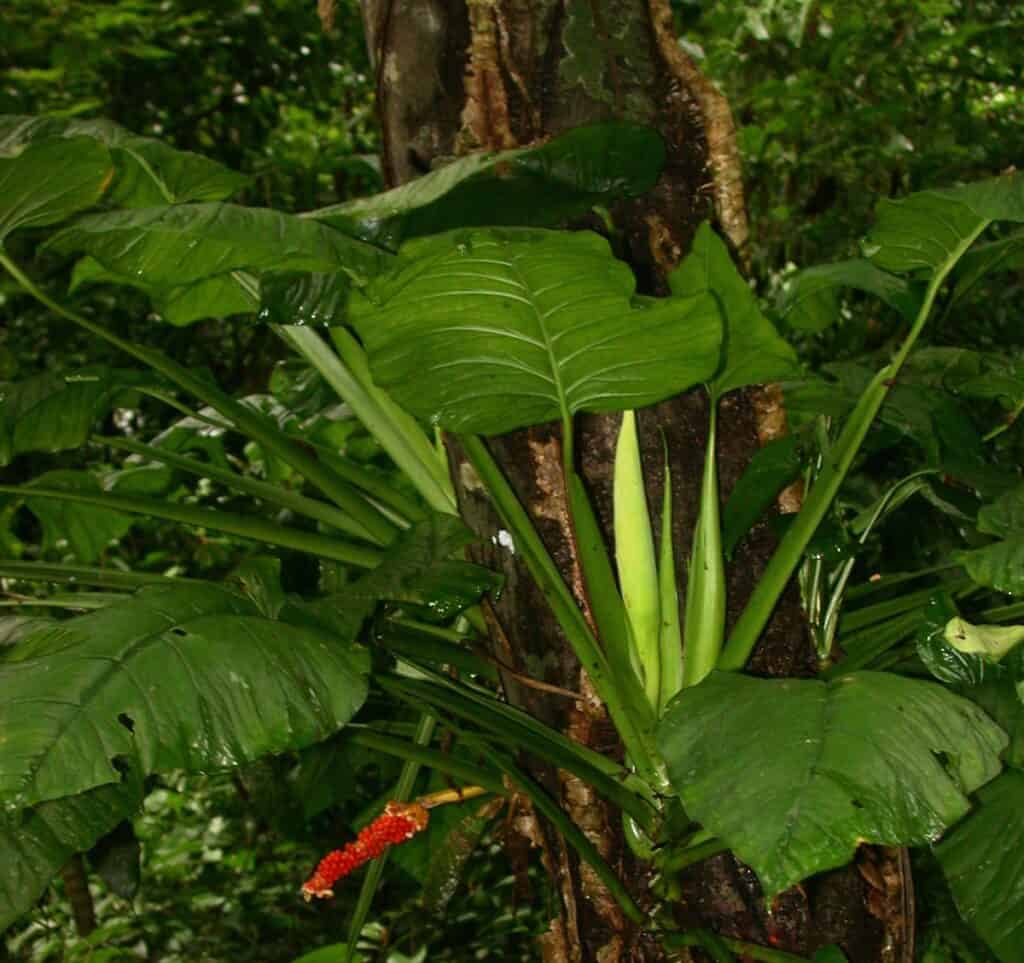
Monstera membranacea is a species of flowering plant in the genus Monstera, native to Costa Rica and W. Panama. It is easily recognized by its unique characteristics such as a very thin and membranaceous leaf lamina, decurrent spathe on the peduncle, green fruit with a deciduous stylar portion, and spherical seeds with a bump on the surface.
Juvenile plants are similar to M. siltepecana, but many adult features separate the two species. It is an epiphytic vine that climbs and has stem internodes that are terete and adult leaves that are ovate, cordate at the base, with perforations round, uniseriate and situated next to the midrib.
Monstera minima

Monstera minima is native to the Caribbean coasts of Panama and northwest Colombia. It is the smallest species in the Monstera genus when it comes to leaf size and can be easily distinguished from other species due to its long peduncles, which are much longer than the leaves. The species name “minima” refers to its small foliage.
Monstera molinae
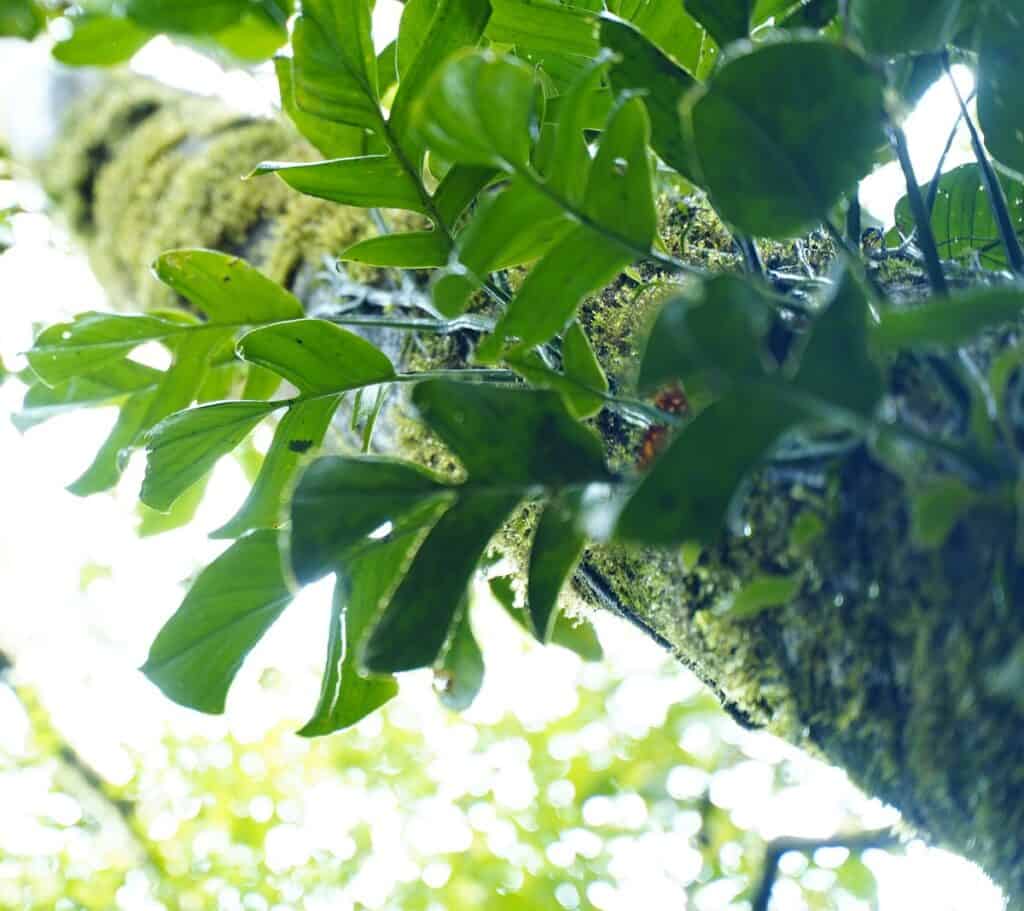
Monstera molinae is a species of flowering plant in the genus Monstera of the arum family, Araceae. It is native to the area ranging from Costa Rica to Central Panama. Not much more information about its specific characteristics or appearance is available.
Monstera monteverdensis
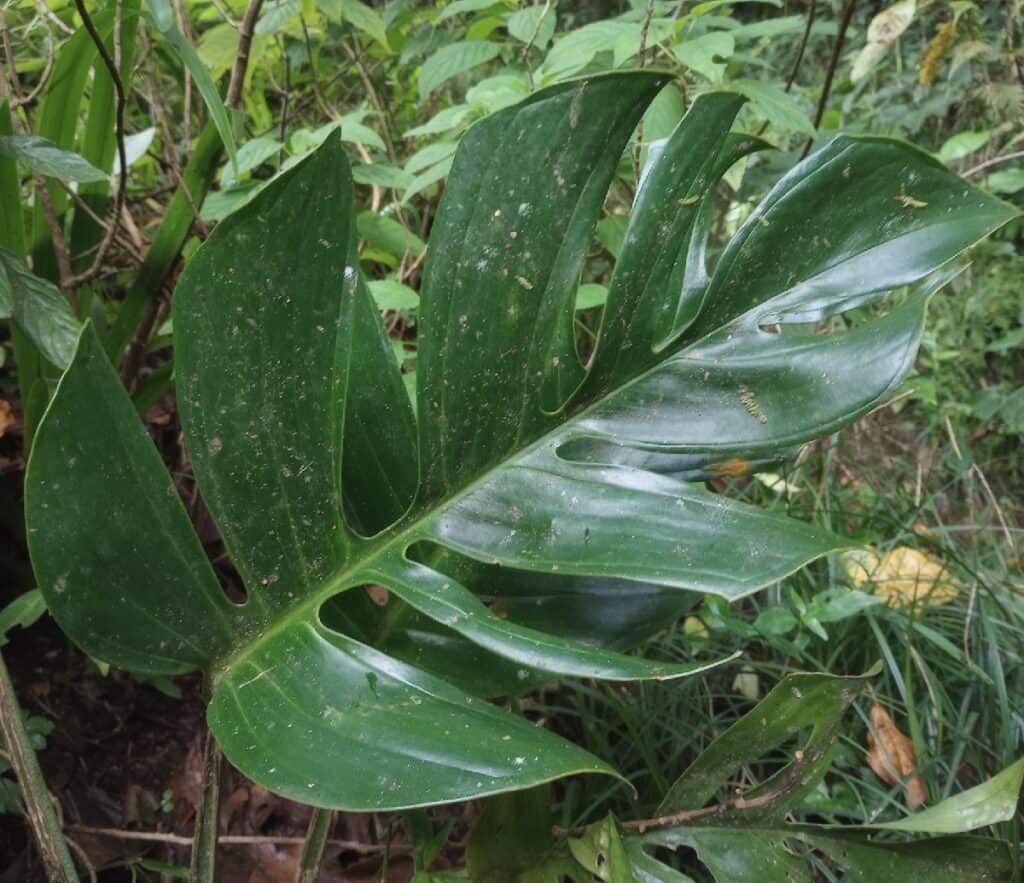
Monstera monteverdensis is native to Costa Rica, specifically the Cordillera de Guanacaste and Tilaran Mountains, and is named after the city of Monteverde where it is abundant. It is easily distinguished by its pinnatifid leaves with up to eight lobes per side and occasional fenestrations away from the midrib.
The leaves of this species can grow up to 60 cm long and 30 cm wide. It has been confused with other species in the genus such as Monstera epipremnoides, Monstera lentii, and Monstera lechleriana, but can be distinguished from these species based on specific characteristics of its leaves.
Monstera obliqua
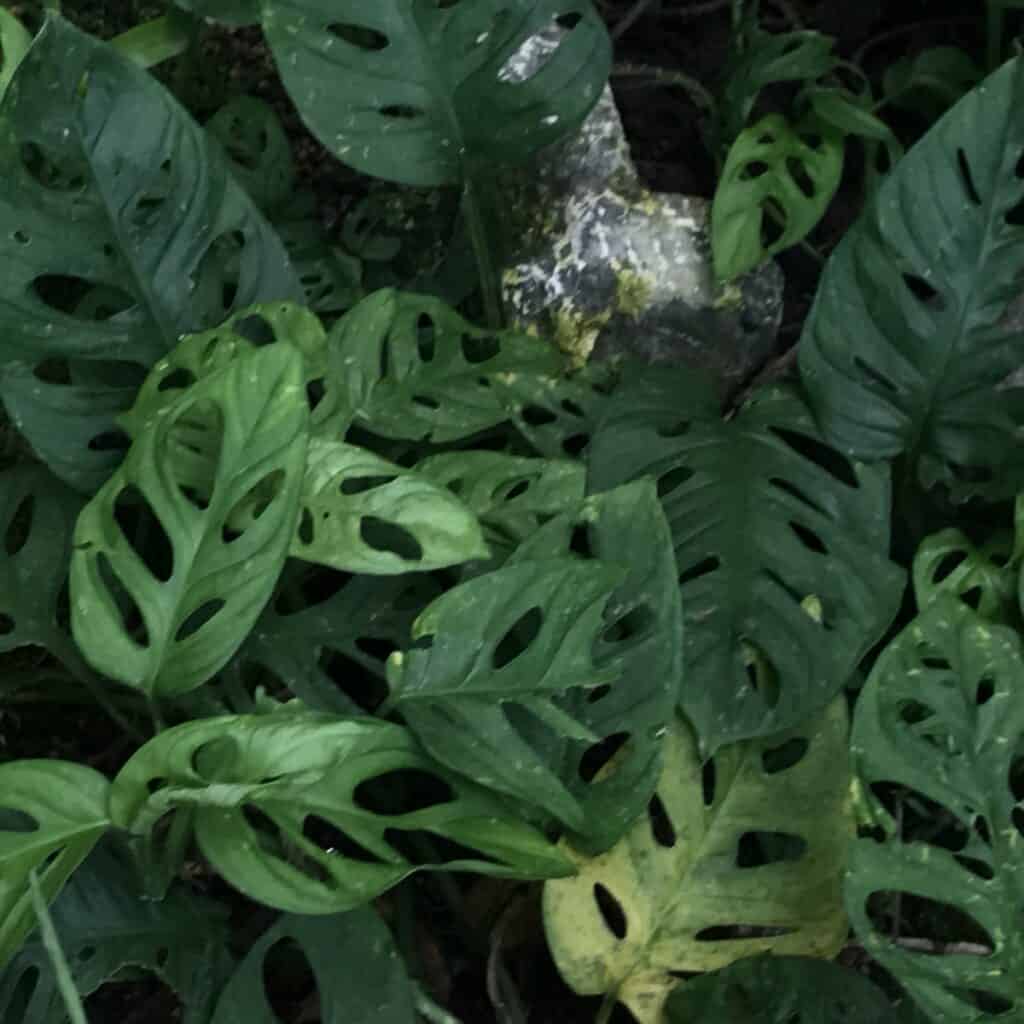
Monstera obliqua is a hemiepiphytic species in the genus Monstera of the arum family, Araceae. It is known for its highly perforated foliage, which can be lanceolate or broadly ovate in shape and can range from 35 cm to 14 cm in length and from 4 cm to 12 cm in width. The leaf margin is entire and the petiole is 5-15 cm long. The stem is green and cylindrical, with internodes that are 10-30 cm long and occasionally produce stolons.
The juvenile form of M. obliqua has distinctive fenestrated leaf blades, while the adult form is characterized by large holes on each side of the midrib. The species is not commonly cultivated and is sometimes confused with Monstera adansonii, which has thicker and more membranous leaves.
Monstera oreophila
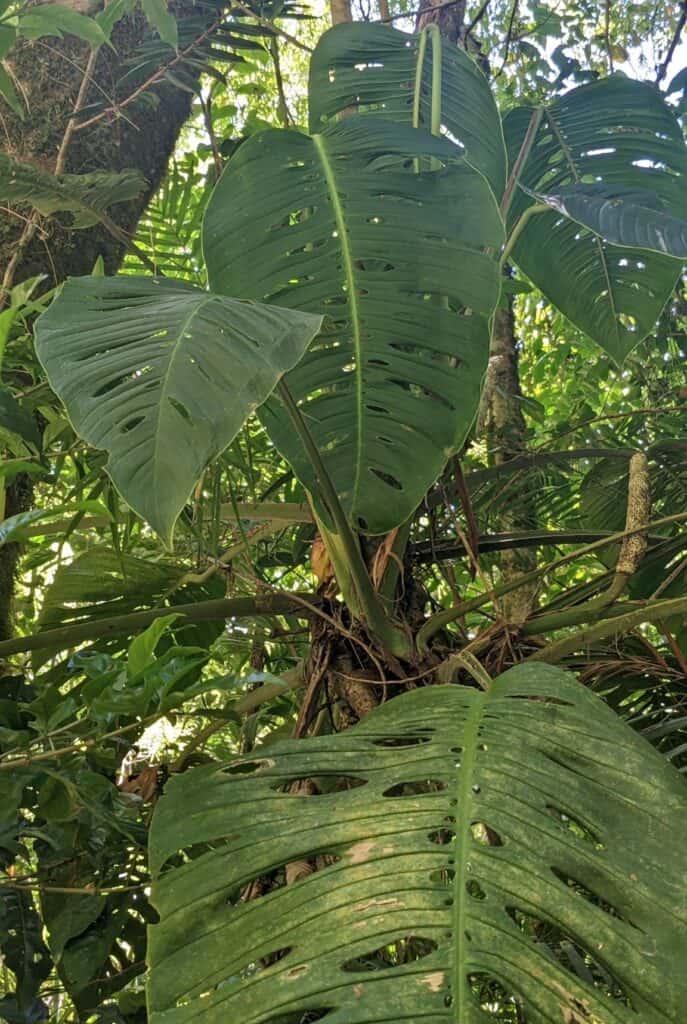
Monstera oreophila is native to Costa Rica and Panama.
Monstera pinnatipartita
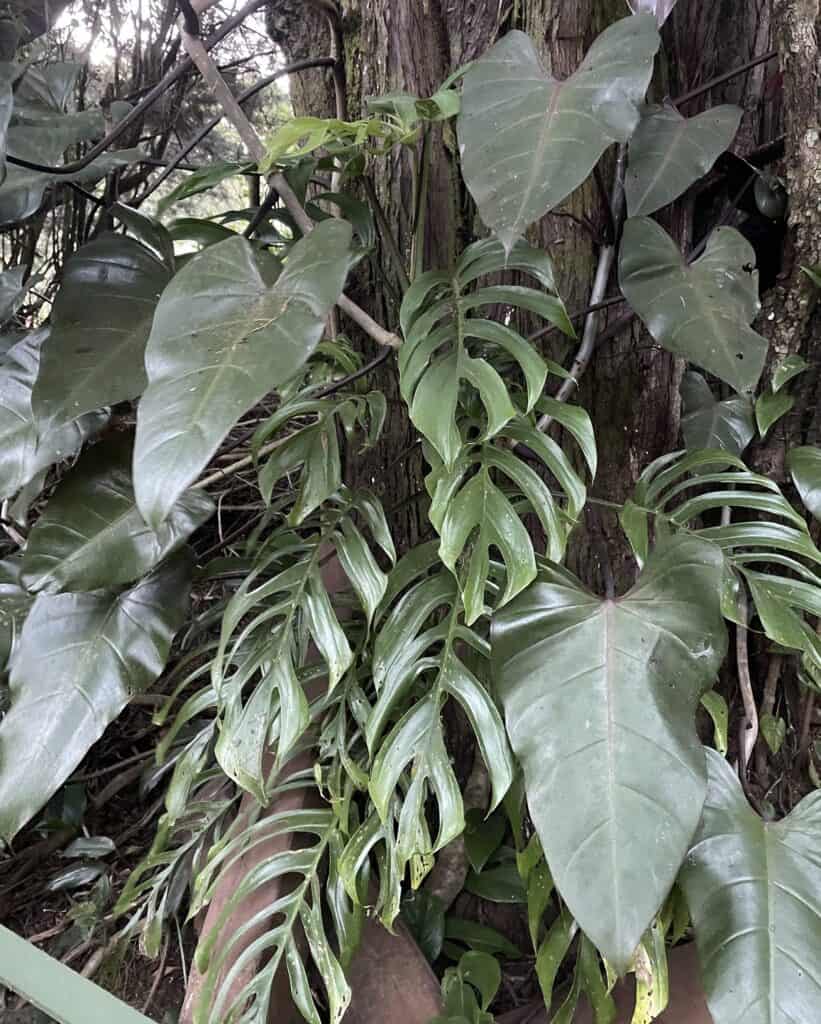
Monstera pinnatipartita is a species of flowering plant in the genus Monstera, belonging to the arum family, Araceae. It is native to South American countries such as Colombia, Ecuador, Peru, and Costa Rica. The plant is characterized by its green foliage that becomes highly fenestrated, with mature leaves being deeply split and pinnate in nature. Unlike the more common Monstera deliciosa, both immature and mature leaves of M. pinnatipartita are less heart-shaped. The name “pinnatipartita” refers to the deeply split mature leaves that are pinnate in nature.
Monstera pittieri

Monstera pittieri is native to the regions of Costa Rica to Colombia, where it is found growing in the wet tropical biome. It is a climbing plant and is known for its unique growth habit and characteristics.
Monstera planadensis
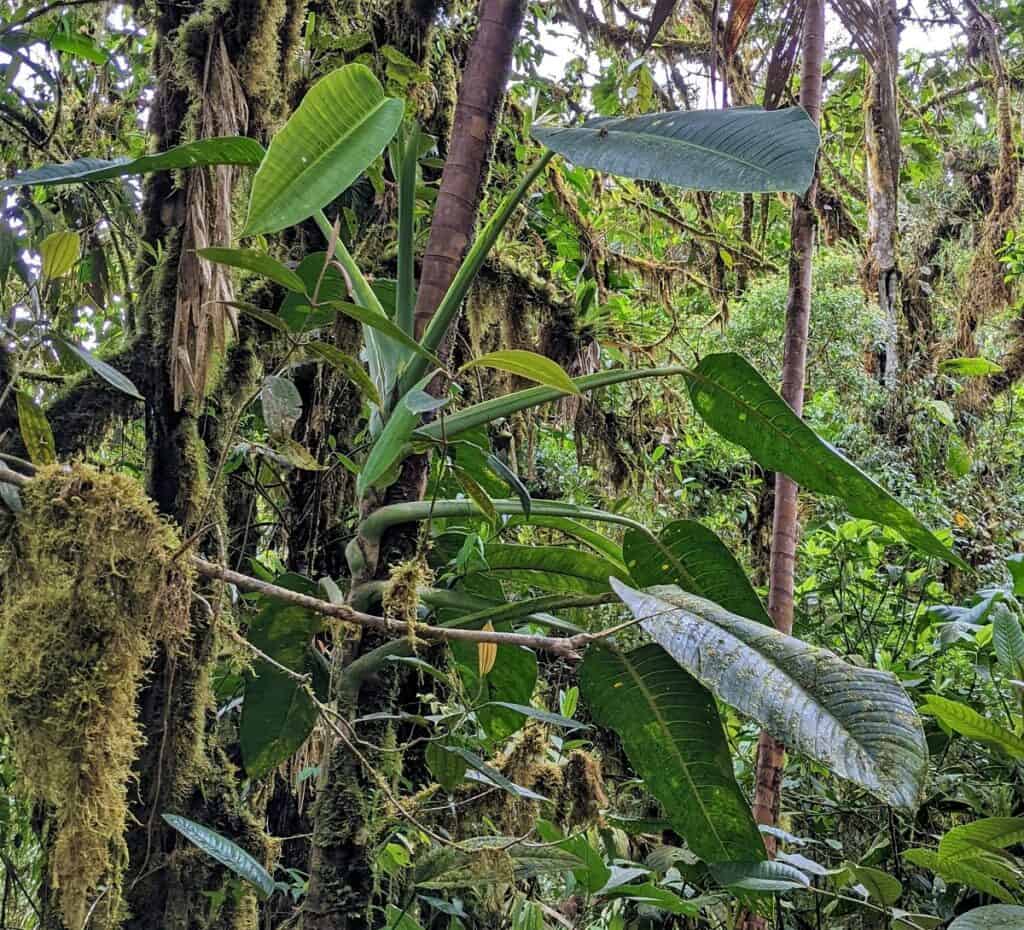
Monstera planadensis is a species of flowering plant in the genus Monstera of the arum family, Araceae. It is native to La Planada in the Premontane wet forest, located at an elevation of 1750 to 1780 meters. The plant is known to grow in the wet tropical biome, where it climbs and thrives in a moist environment.
Monstera praetermissa
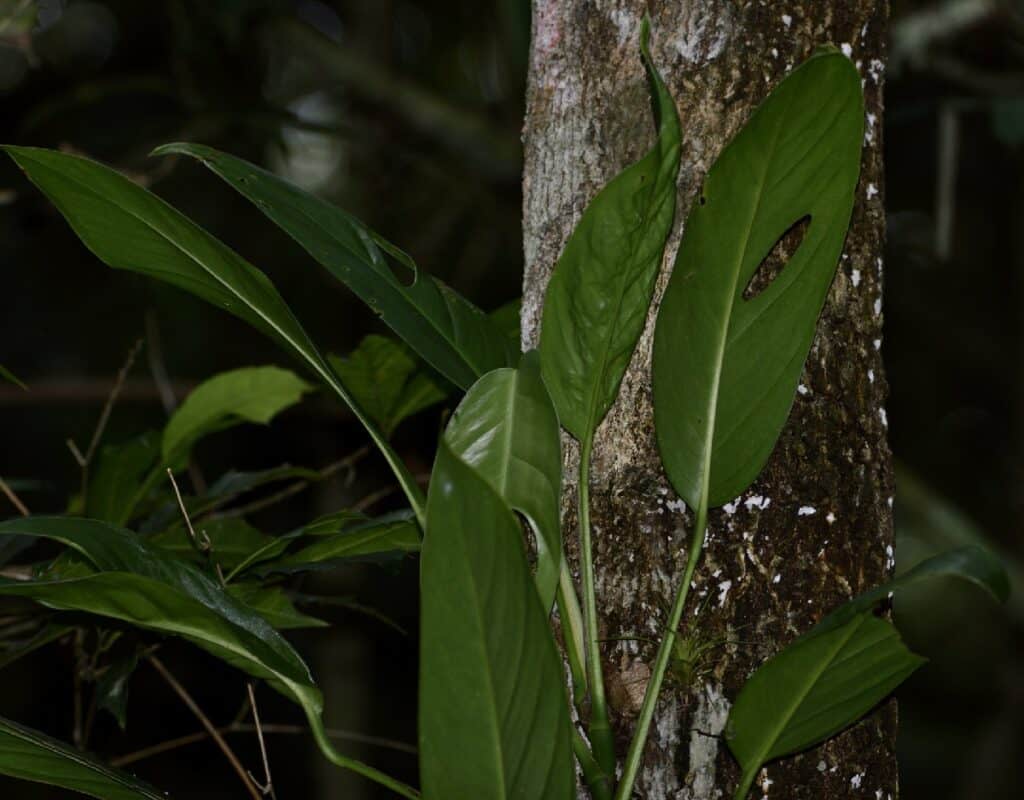
Monstera praetermissa is a rare species of flowering plant in the genus Monstera of the arum family, Araceae. It is known to be one of the rarest species in the genus and is only found in Brazil with only 8 documented observations in the wild. The species is considered to be almost non-existent in collections. This species is native to Brazil and is known to be highly sought after by collectors and enthusiasts due to its rarity.
Monstera punctulata

Monstera punctulata is a tropical plant that grows to a height of 15 meters and is found in Central American countries such as Belize, Costa Rica, and Panama. The stem of the plant is brown in color and is 3-4 cm in diameter, with 3-6 cm long internodes. The petiole is either smooth or tuberculate and can be densely flecked with white spots that are 30-55 cm long. The leaves are bright green, soft in texture, and not glossy, with a lamina that is 60-120 cm long and 35-60 cm wide. The spathe is white, obovate, and 15-18 cm tall, with a flowering spadix that is deep green to greenish-gold colored and 14-19 cm long and 3.5-5.5 cm thick.
Monstera siltepecana
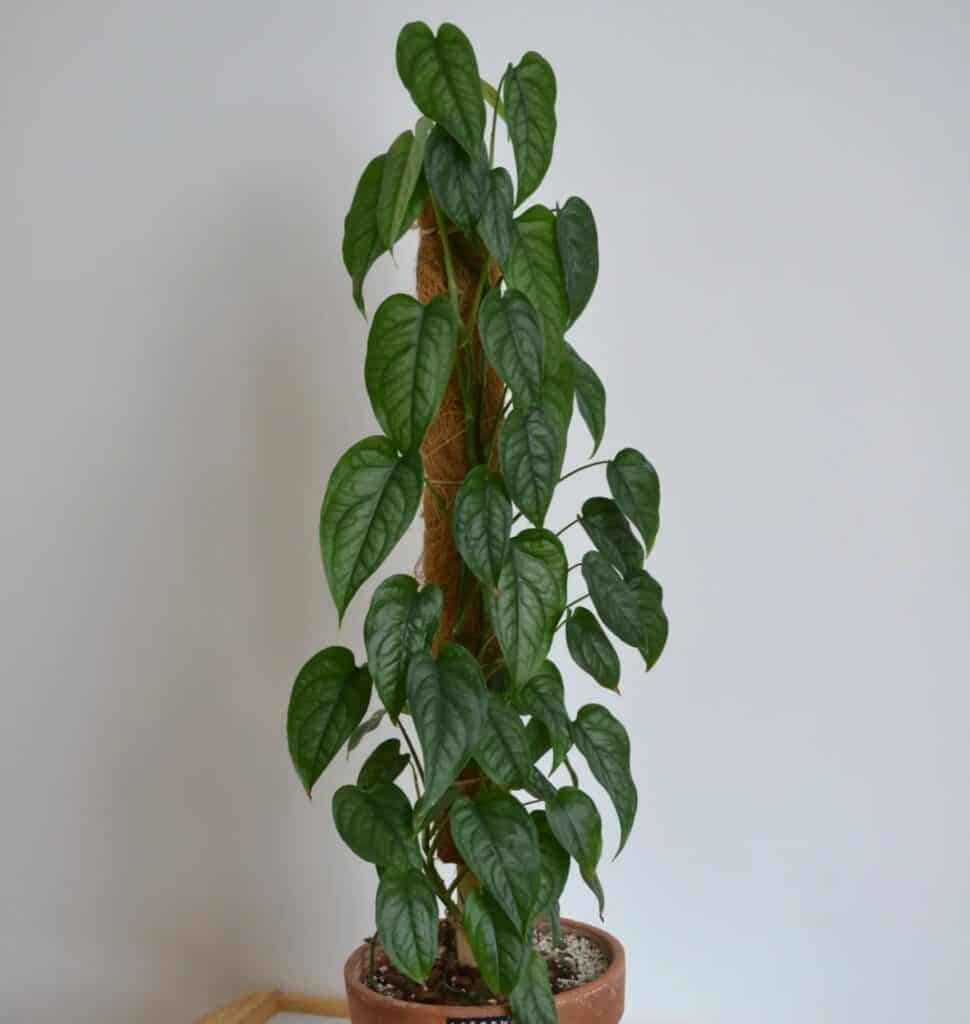
Monstera siltepecana is a vining plant species of the Monstera family. It is characterized by the development of holes in its leaves as it matures, and distinctive silver venation, especially in immature foliage. It is known for its fast growth, along with other members of the arum family.
Monstera spruceana
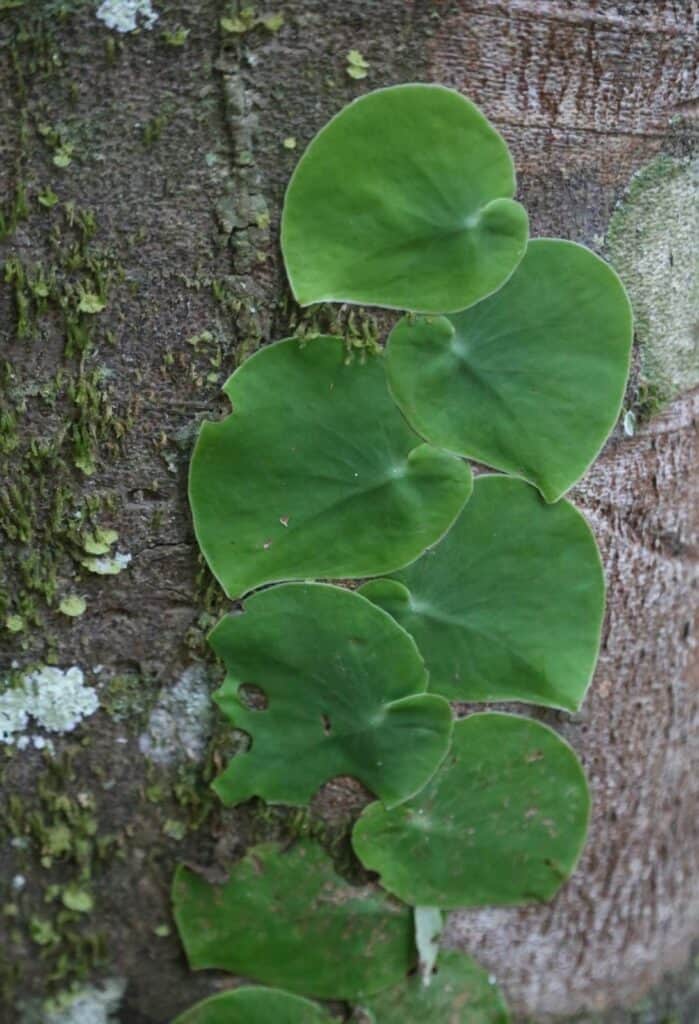
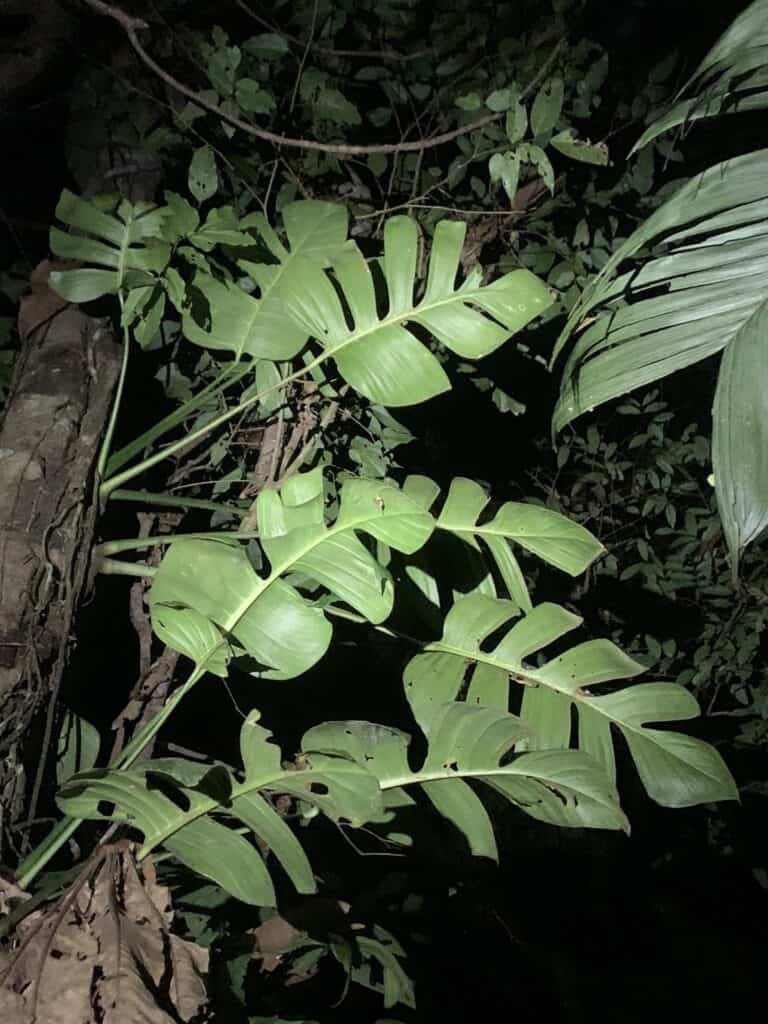
Monstera spruceana is a species of plant native to countries in South America such as Bolivia, northern Brazil, Colombia, Costa Rica, French Guyana, Guiana, Panama, Peru, Suriname and Venezuela. It is known for its large and deeply lobed spruce-like leaves, which are dark green with white splotches or streaks.
The species can grow up to 6 feet tall and can be found growing at elevations ranging from 70 to 1400 meters above sea level. It can grow as an epiphyte or hemiepiphyte, getting its nutrients and water from the air or organic debris.
The plant has a juvenile stage in which it grows appressed against its host, giving it a shingle-like appearance. The adult leaves are bicolored and less than leathery to moderately leathery.
Monstera standleyana
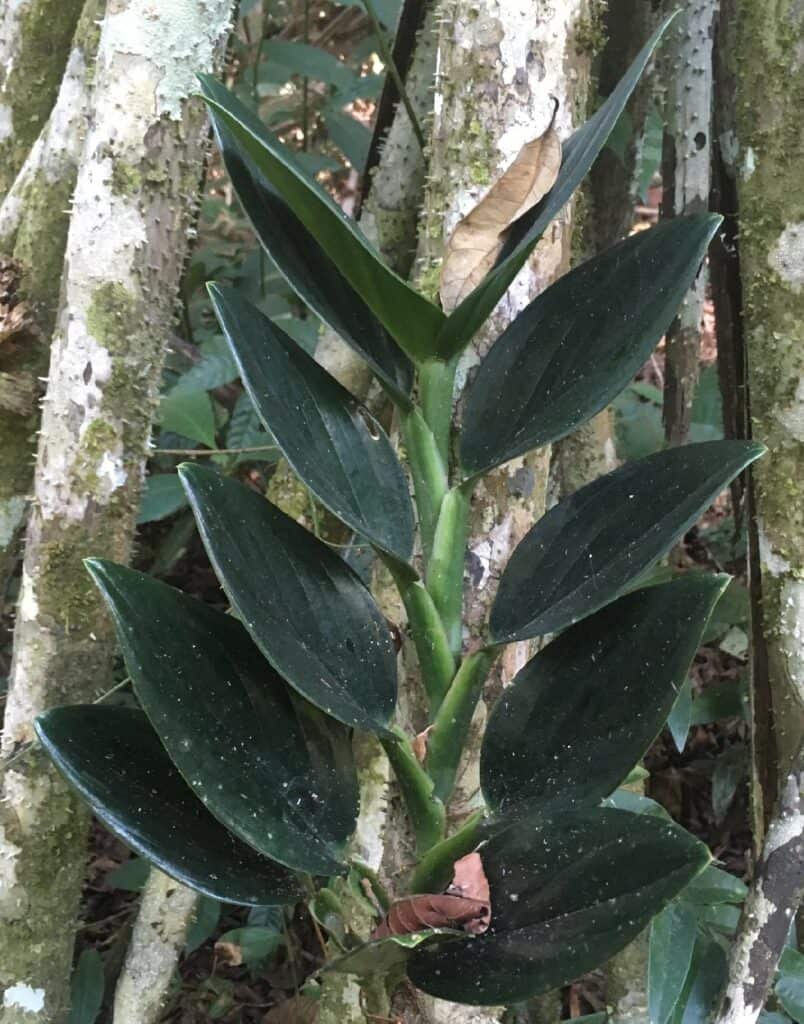
Monstera standleyana is a climbing or trailing plant that is native to South and Central America. It has small, oval-shaped leaves that are about 6-8 inches long at their largest, with a deep green glossy appearance and stunning variegation in white speckles, splashes, strokes, or bands.
The leaves can have a wide variety of variegation patterns, with some being lightly variegated and others having heavy variegation. Unlike other monstera varieties, Monstera standleyana does not develop fenestrations as it matures, although the leaves can increase in size, which can be helped by giving the plant something to climb.
Monstera subpinnata
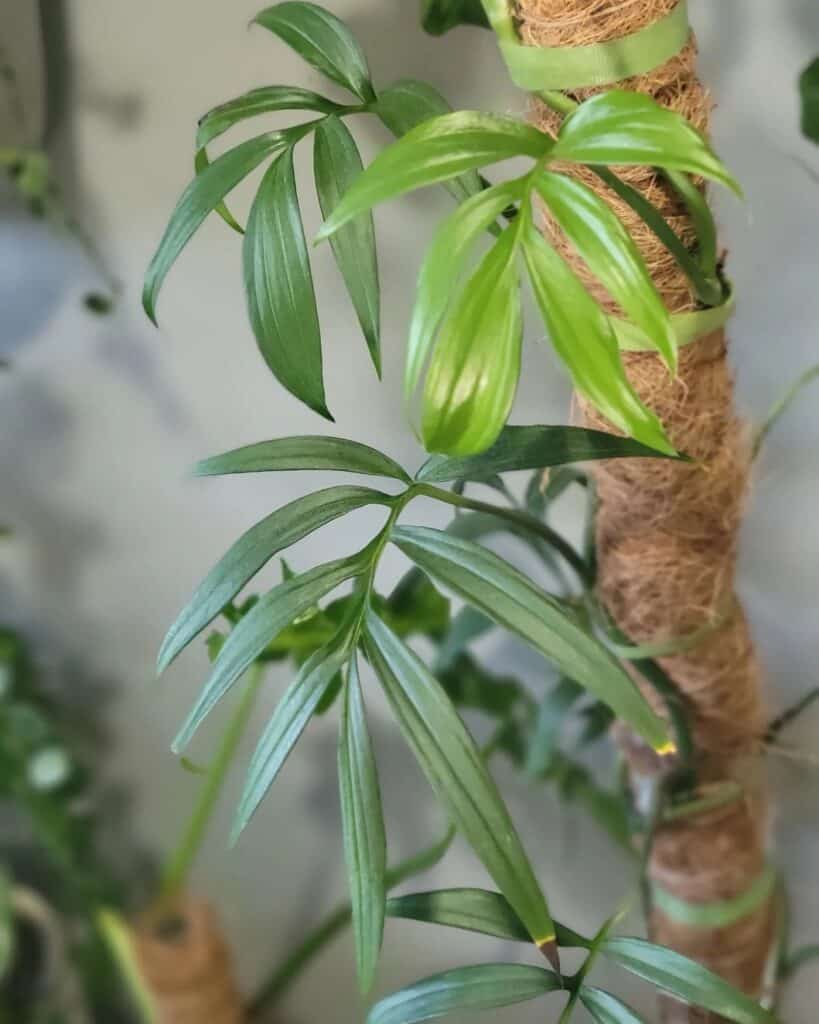
Monstera subpinnata is a species of flowering plant native to South America and is an epiphyte. It grows tall, up to 12 meters, with large, pinnate leaves that can be as long as 40 cm and as wide as 30 cm. It is known for its unique leaves within the Monstera genus and is a moderate to fast-growing plant that requires a humid environment to thrive.
Monstera tacanaensis
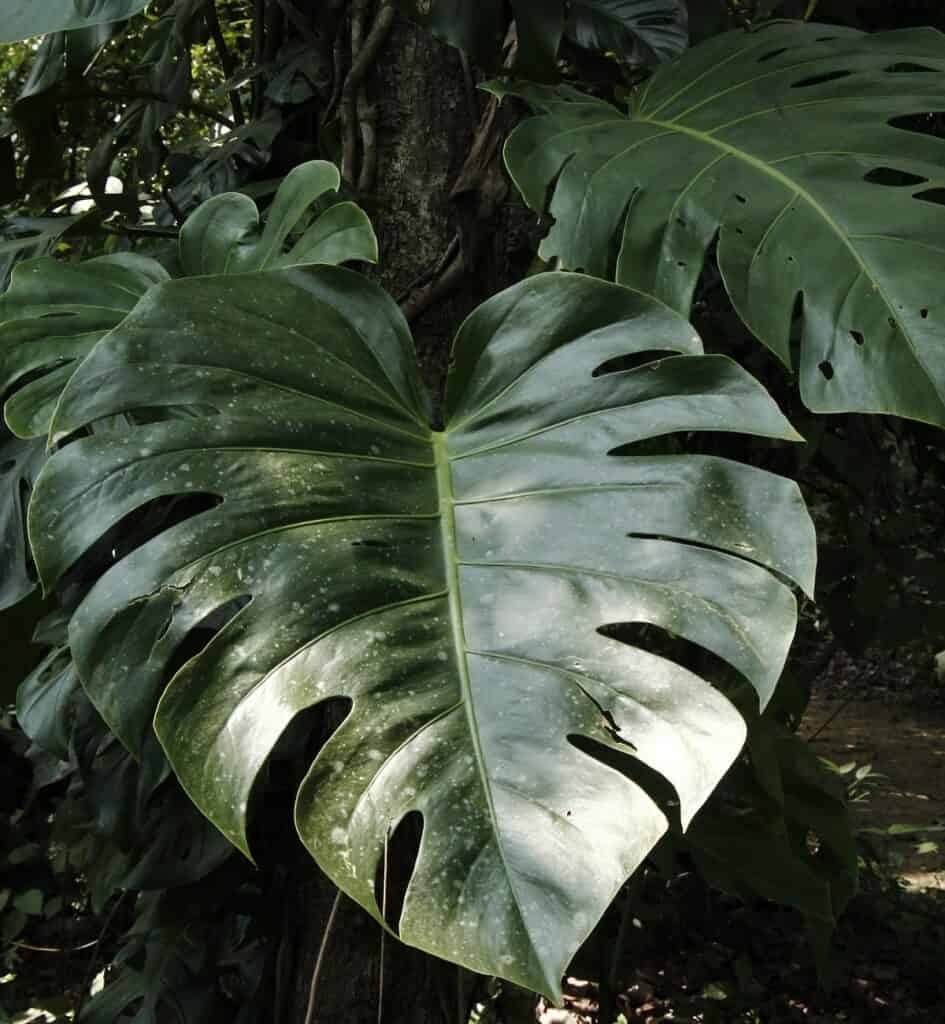
Monstera tacanaensis is a species of flowering plant belonging to the Monstera genus. It was previously considered to be a synonym of Monstera deliciosa, but recent studies have shown that it is a distinct species.
This plant species is characterized by its leaves that are 18-55 cm long and can be either perforated or imperforated. When perforations are present, they are of roughly similar sizes. The spathe, which is the protective bract surrounding the flowering spadix, is green or grayish in color and pruinose (covered in fine, white powder) before it opens. The spathe is 13-16 cm long and the flowering spadix is 5-15 cm long.
Monstera tenuis

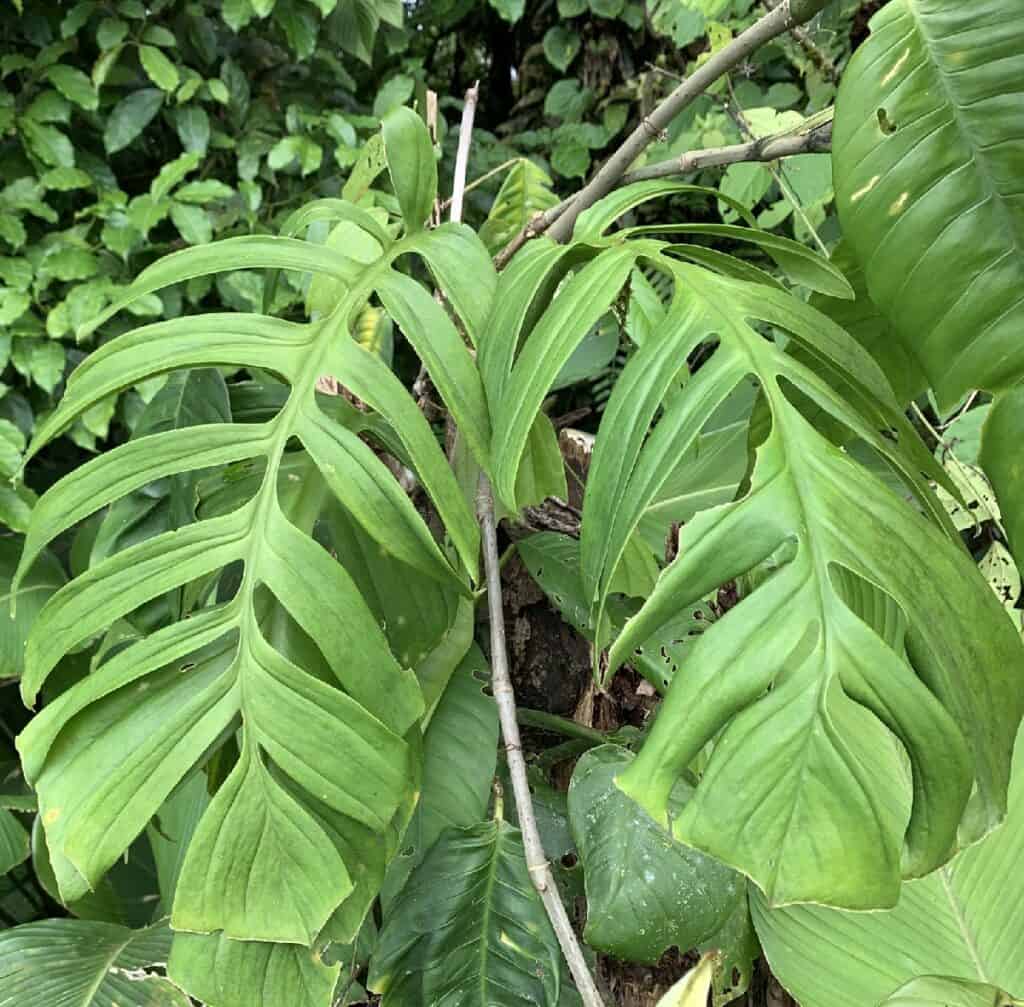
Monstera tenuis is a tropical climbing plant native to Costa Rica. It can grow up to 30m tall in the wild, with an open growth habit and arching leaves. Juvenile plants have nearly round leaves, while adult plants have smooth stems with shallow leaf scars and oblong-ovate leaves that are deeply and regularly pinnatifid. The petioles are one-third to half the length of the leaves and the primary lateral veins are prominent and white. The white flowering spadix is cylindric and tapering, while the fruiting spadix is green, turning yellow at maturity. The seeds are oblong and pistachio-green inside.
Monstera tuberculata
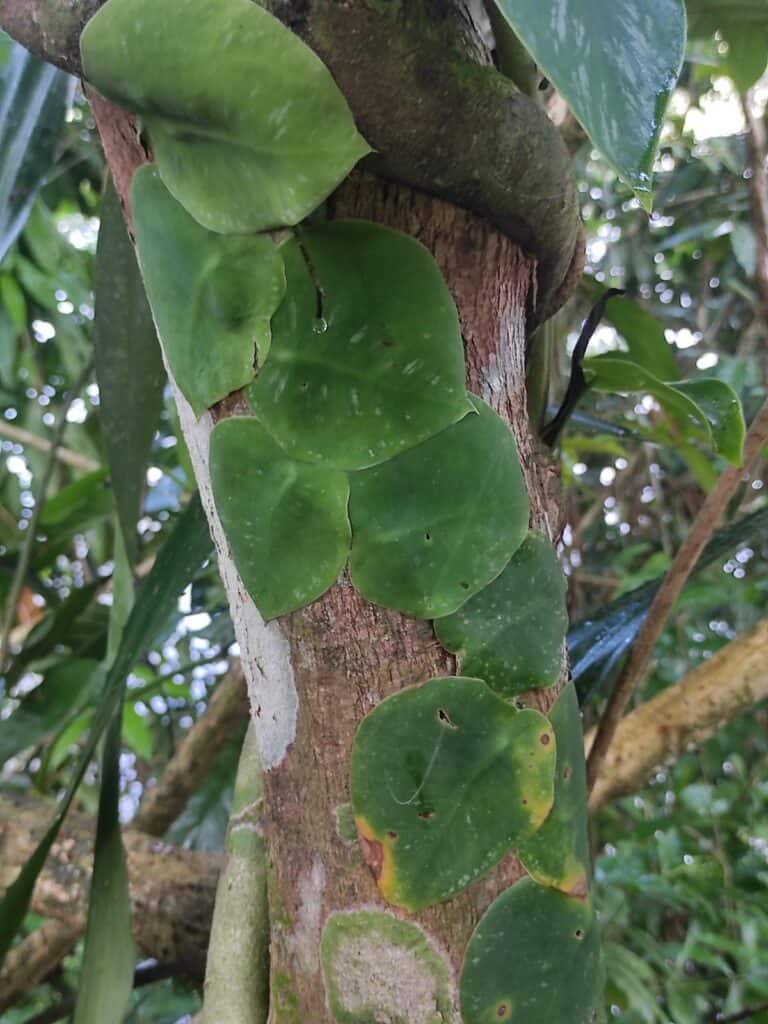
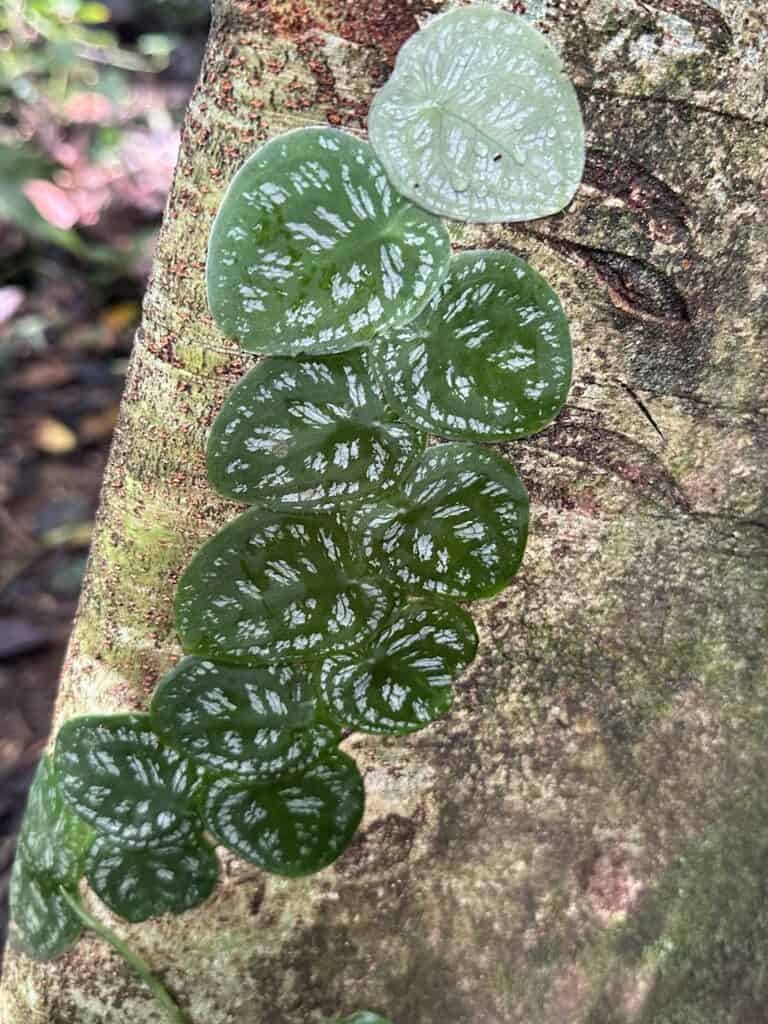
Monstera tuberculata, also known as the velvet shingler or velvet shingle, is a rare type of Monstera plant that is known for its large heart-shaped leaves with a velvet-like texture. The leaves are flat, curl around surfaces, and lack the fenestrations found in other Monstera varieties. As the plant matures, the leaves can reach 3 inches wide and grow in an alternating pattern. It is typically grown indoors as a houseplant and is less commonly available compared to other Monstera species.
Monstera xanthospatha
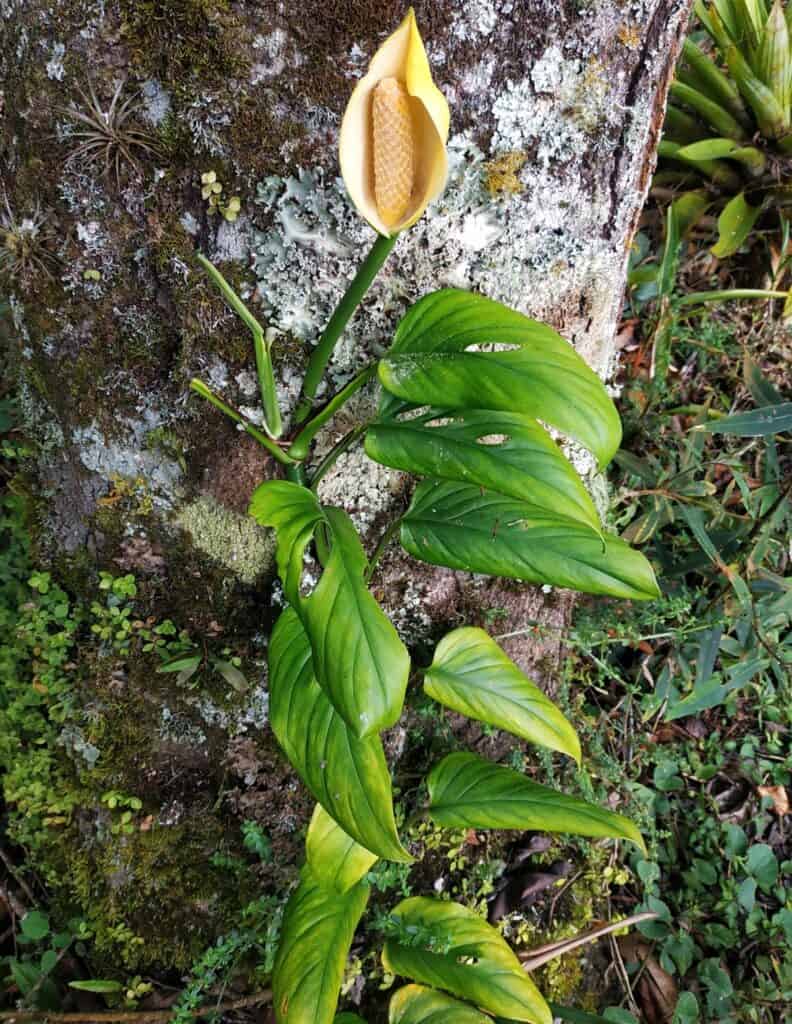
Monstera xanthospatha is a rare species of the Monstera plant. It has a terete stem that is 5-10 mm thick and has internodes that are 3-6 cm long. The petiole is 12-18 cm long and is sheathed to the geniculum with a deciduous sheath. The leaf blade is obliquely lanceolate and is 16-25 cm long and 5-8 cm wide. It is unequal, cuneate-angustate at the base, acute at the apex and is either entire or has a few perforations between the primary veins.
The perforations are solitary, narrowly elliptic and can be up to 5 cm long. The peduncle is 15-26 cm long, which is slightly longer than the petiole. The spathe is golden on the outside and white on the inside and is approximately 9 cm long. The flowering spadix is yellow and is 6-8 cm long and 2 cm thick, with the lowest portion being sterile. The fruiting spadix is nutant and can be orange or red, with subprismatic berries.
